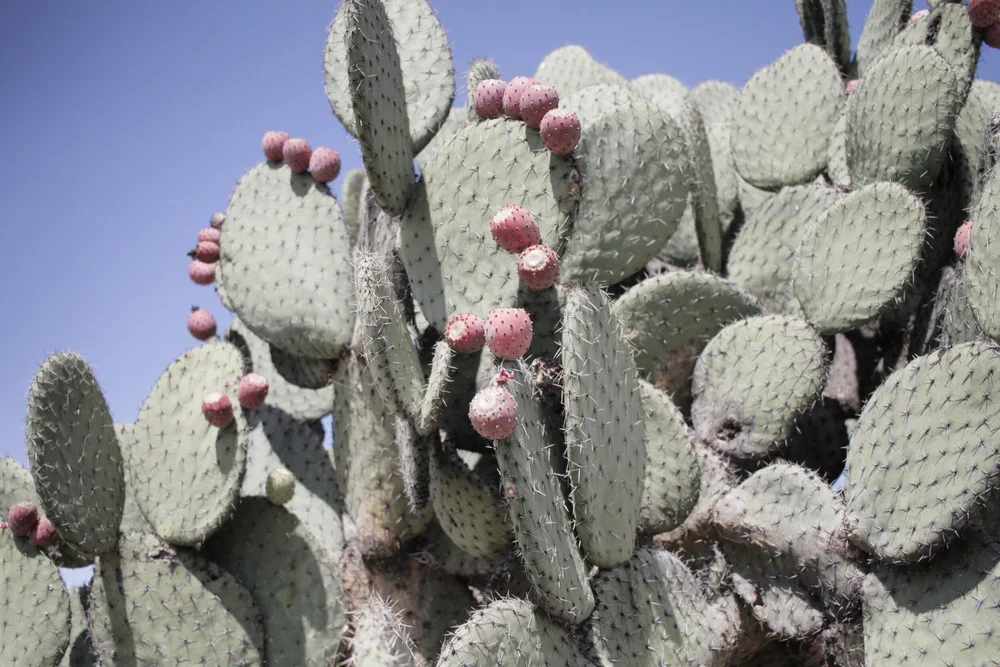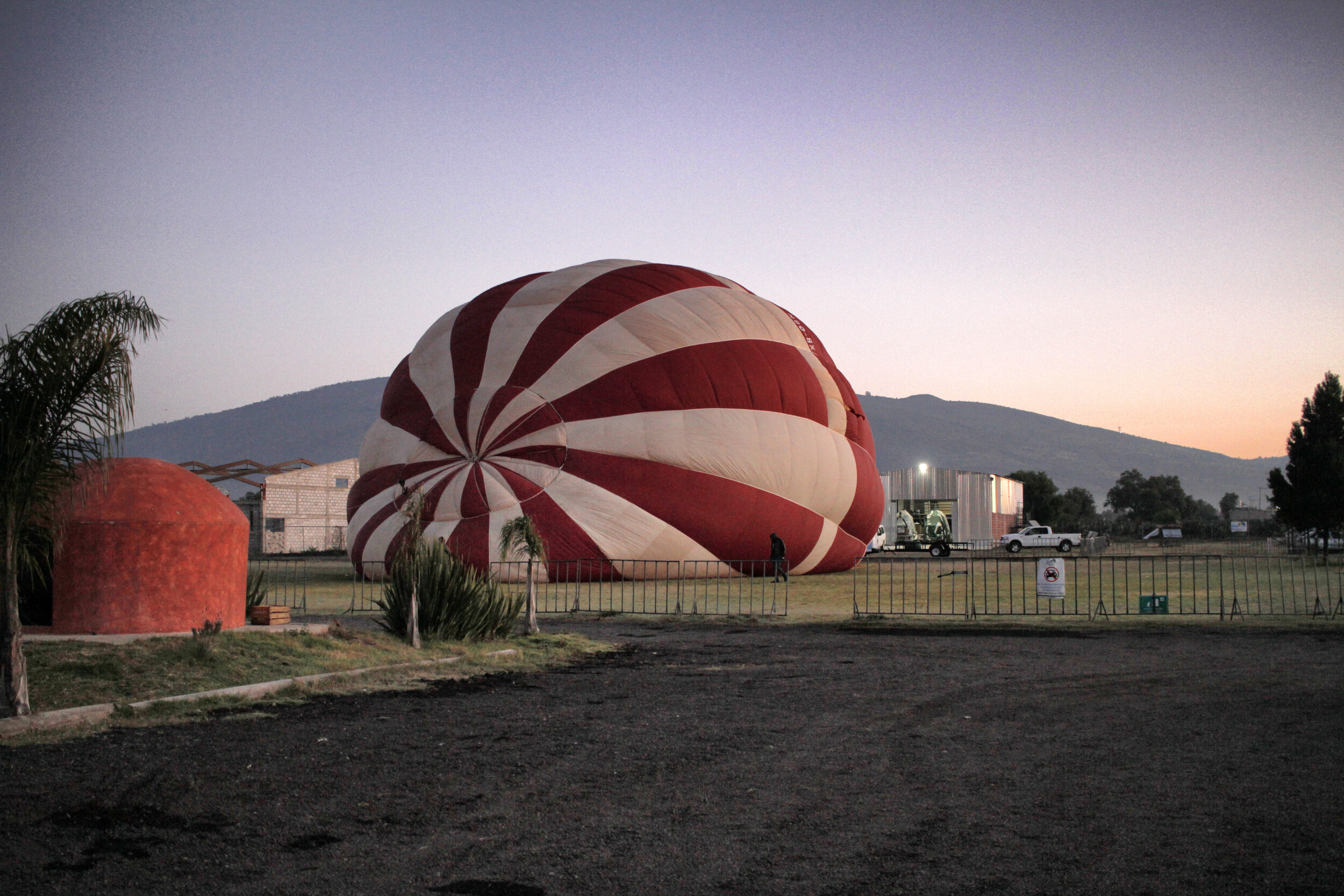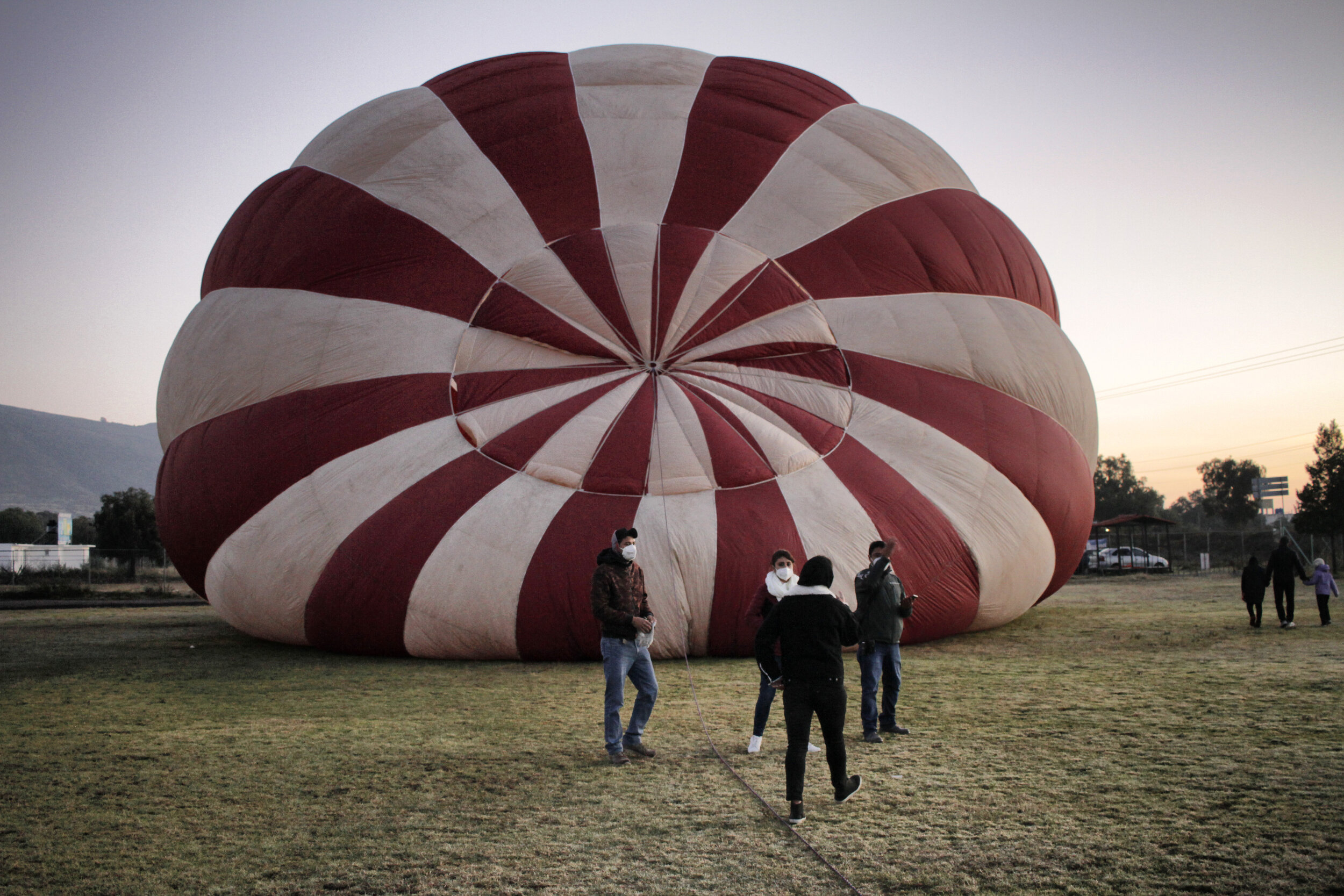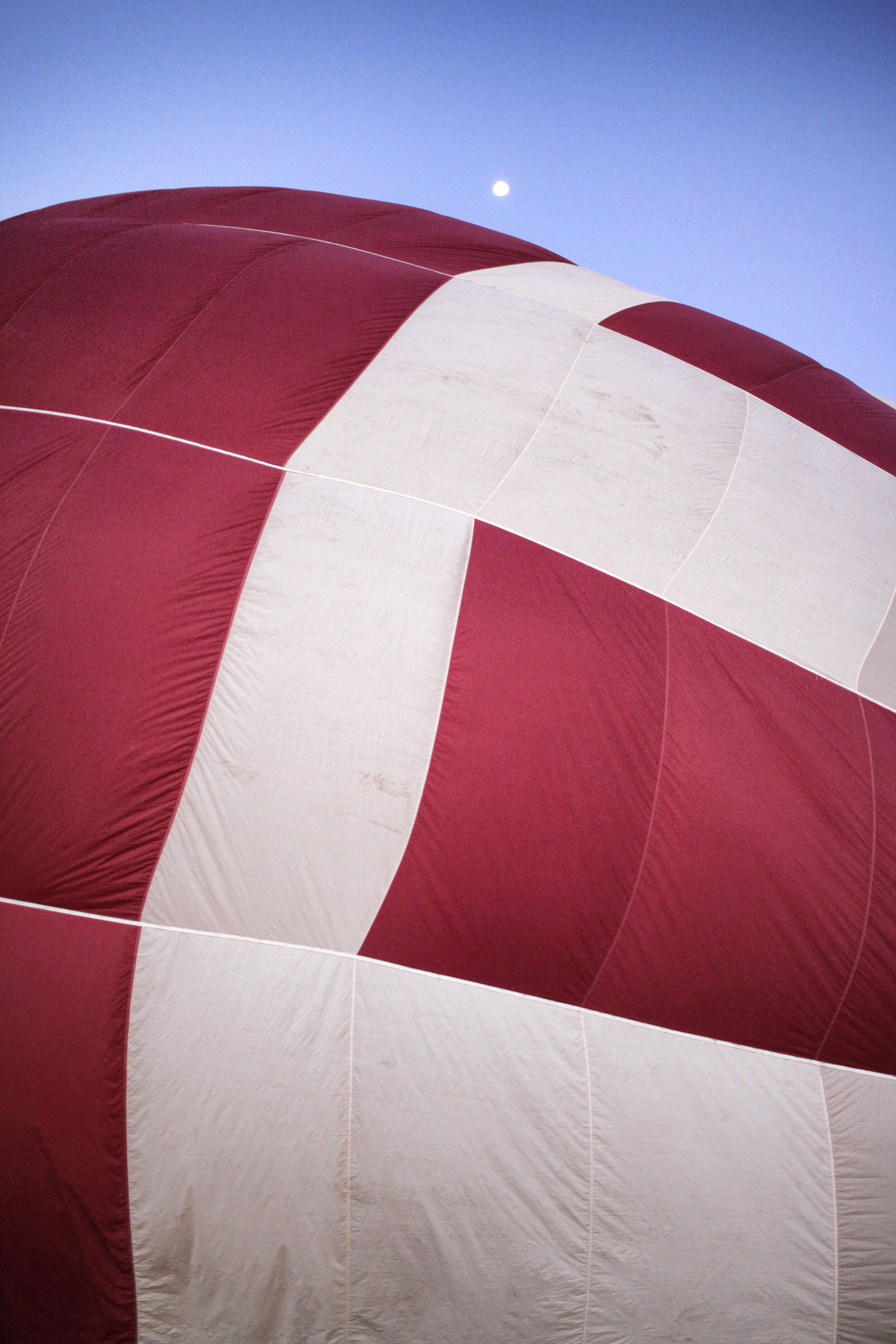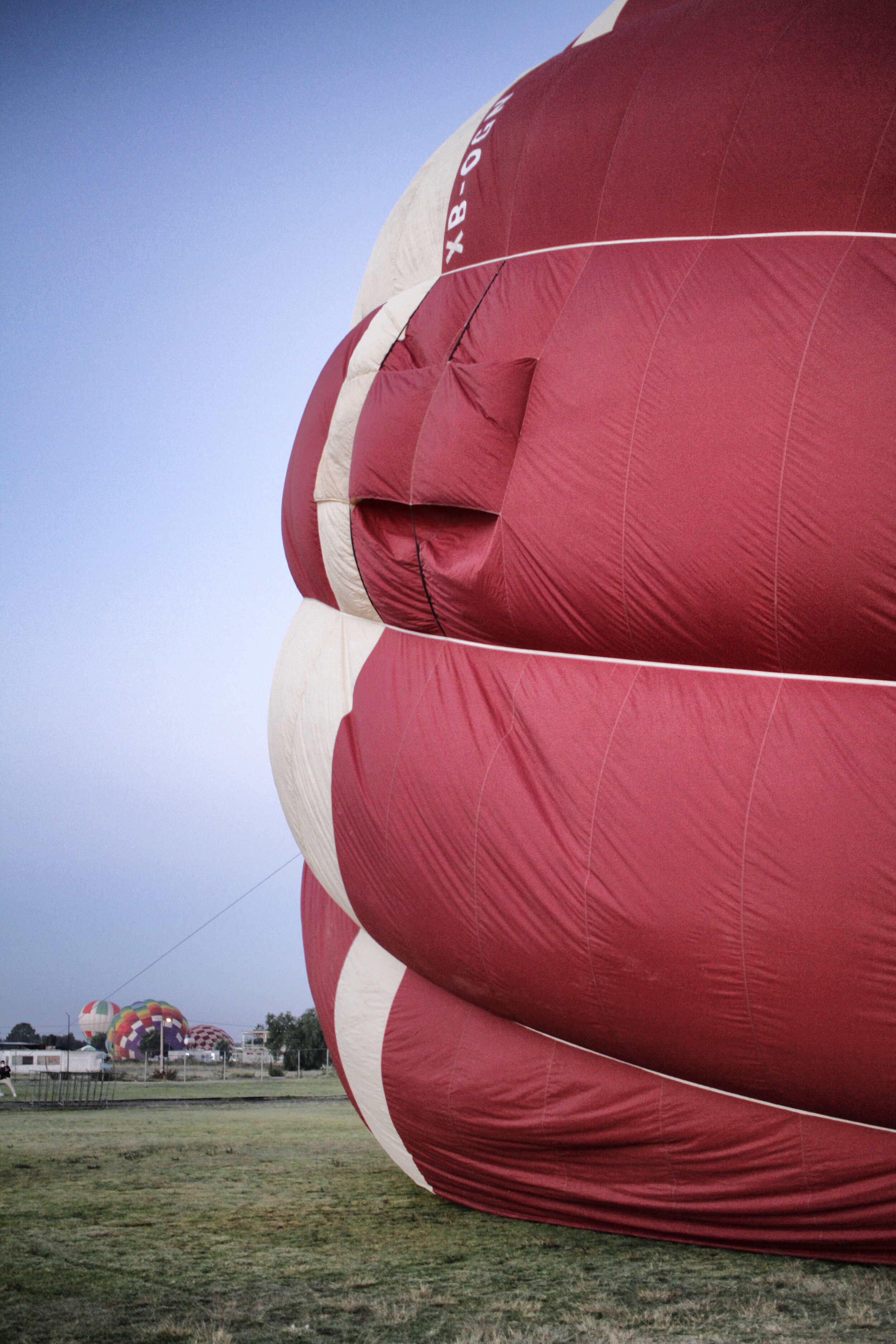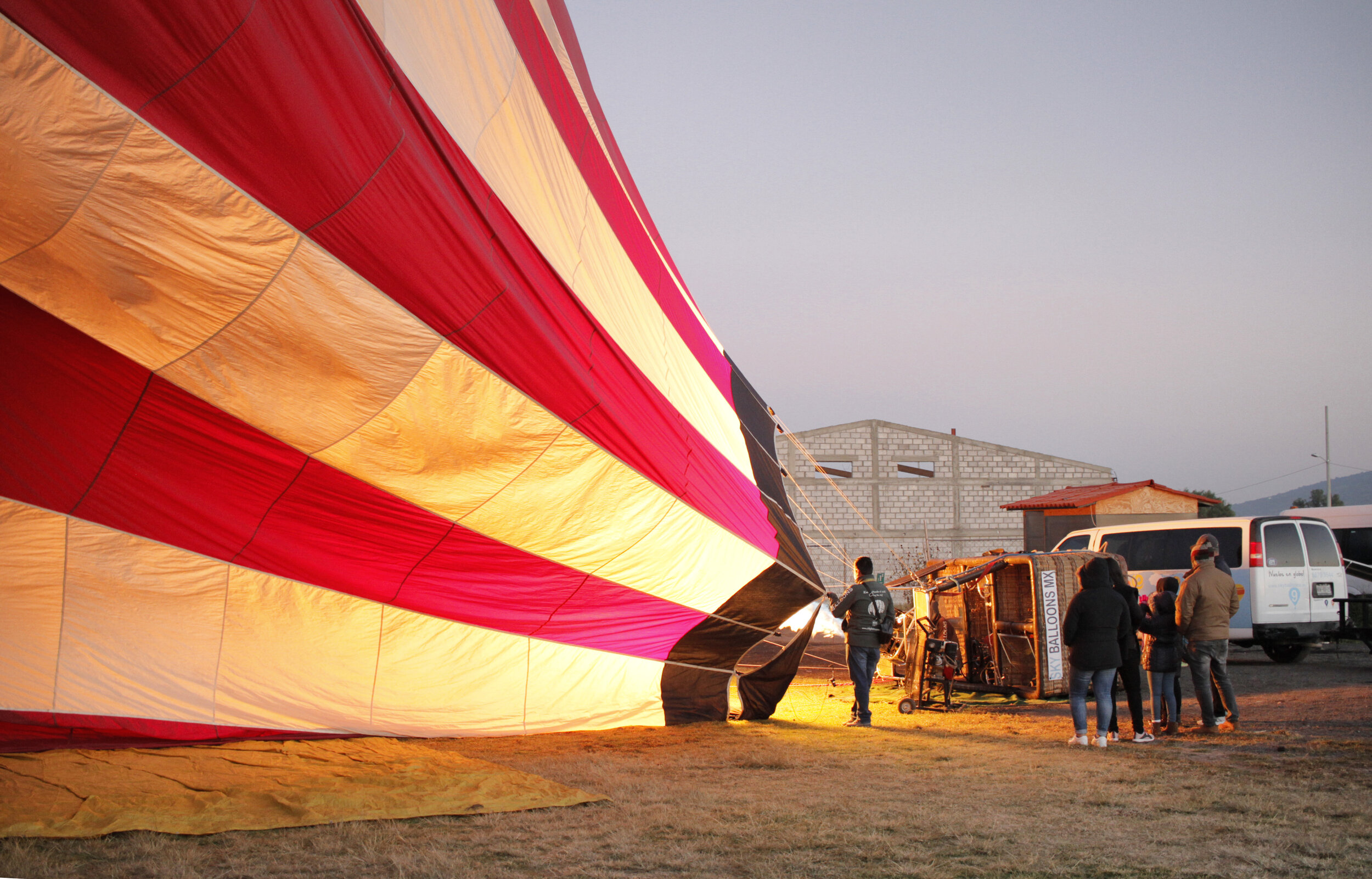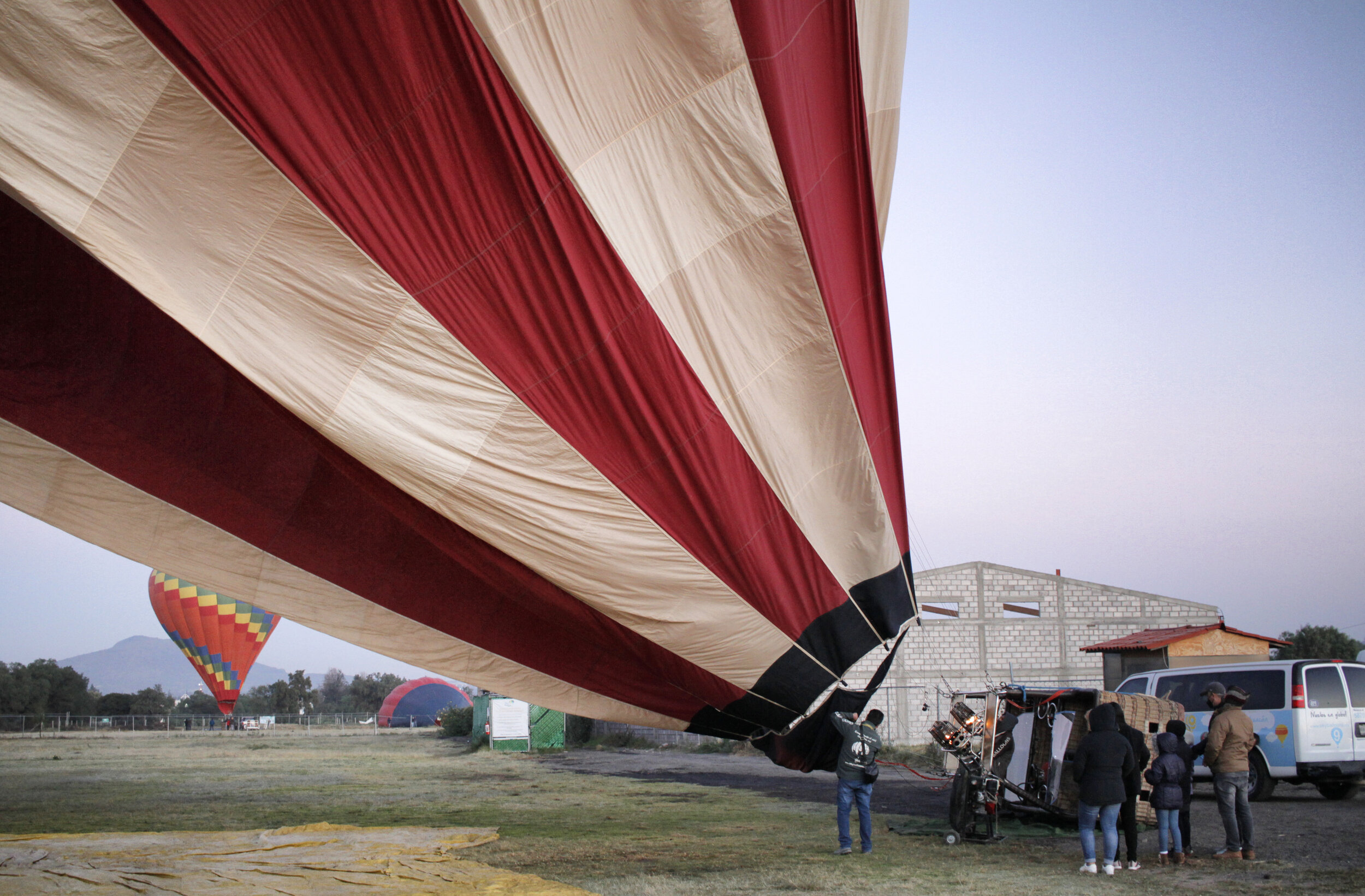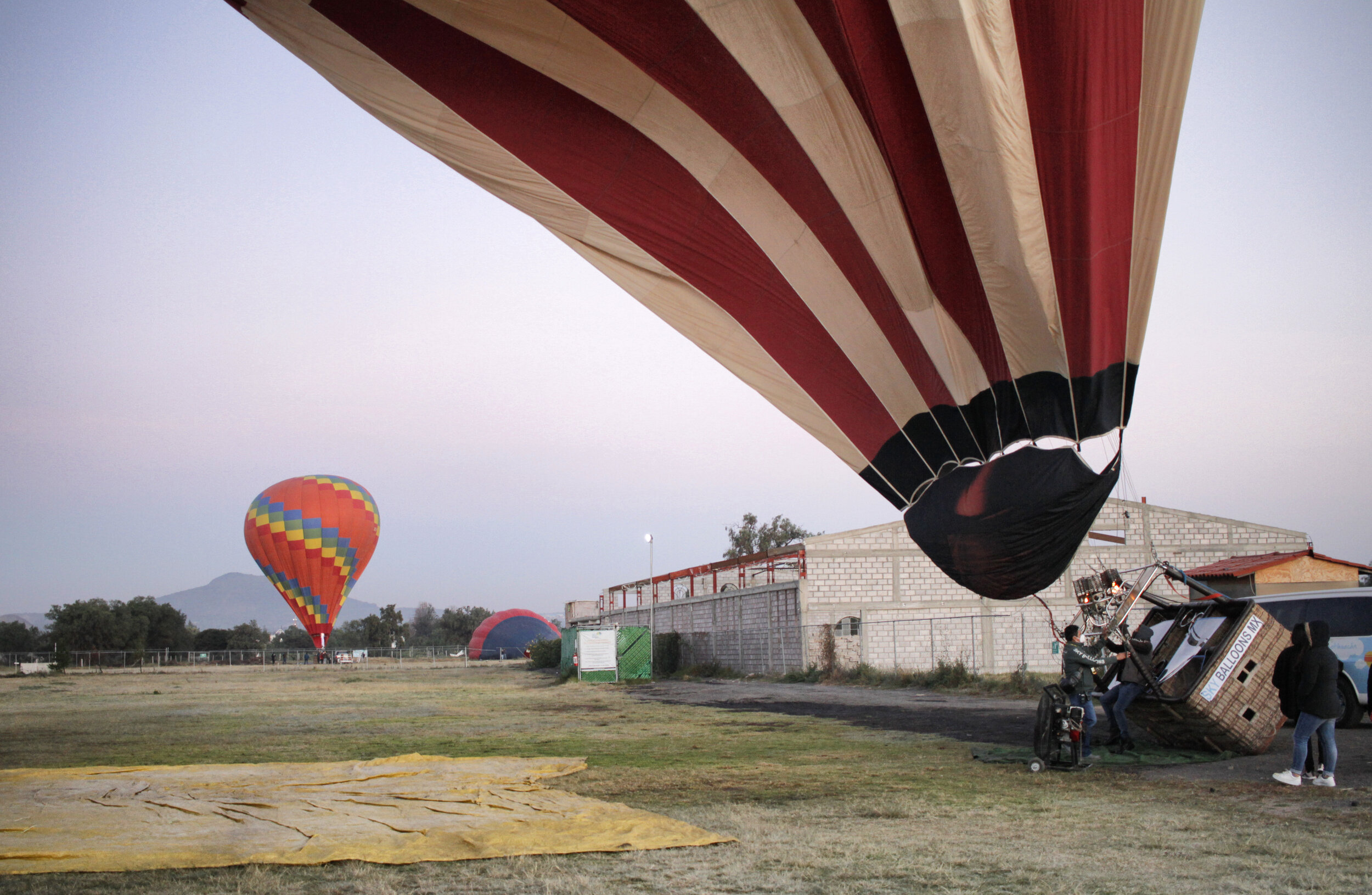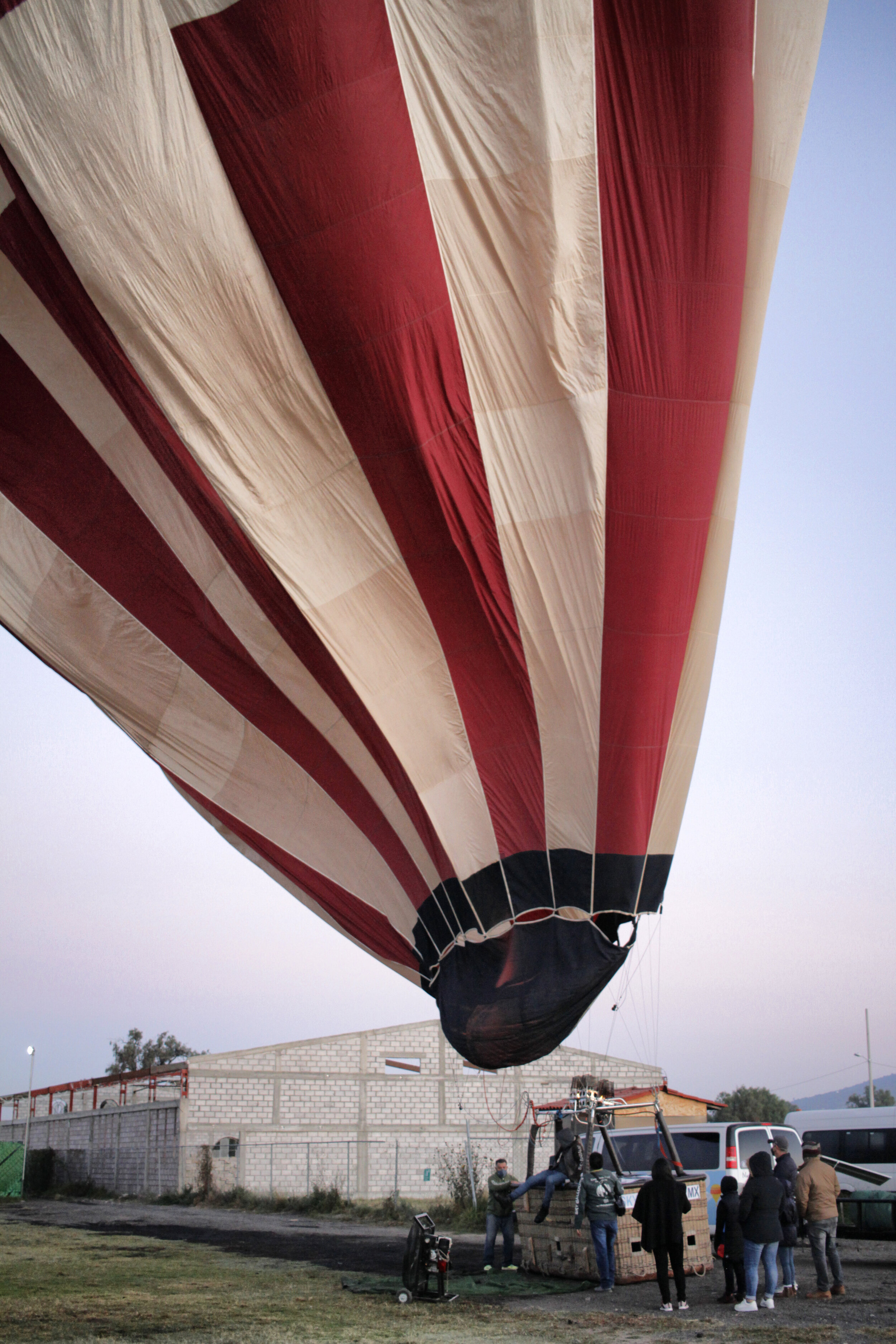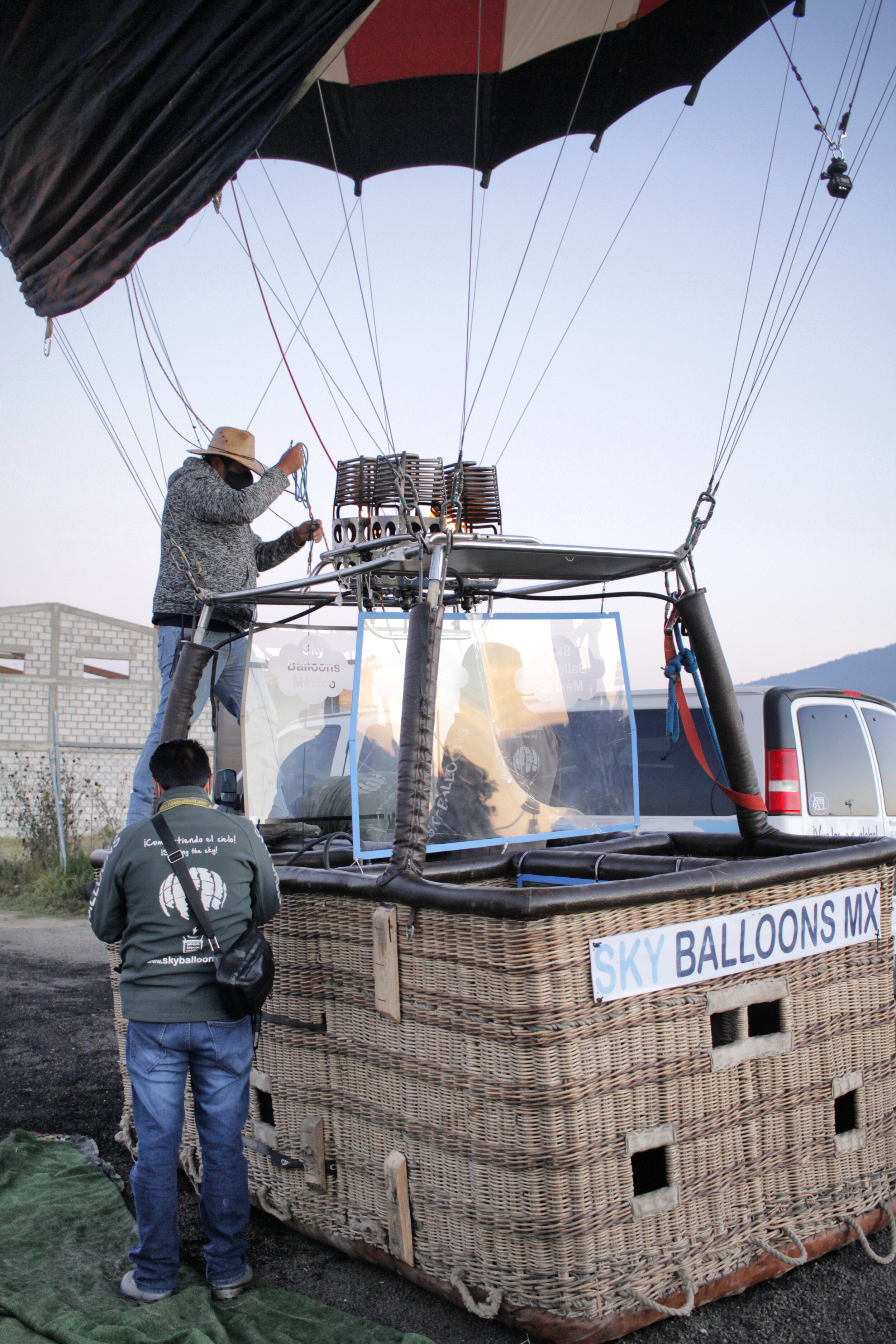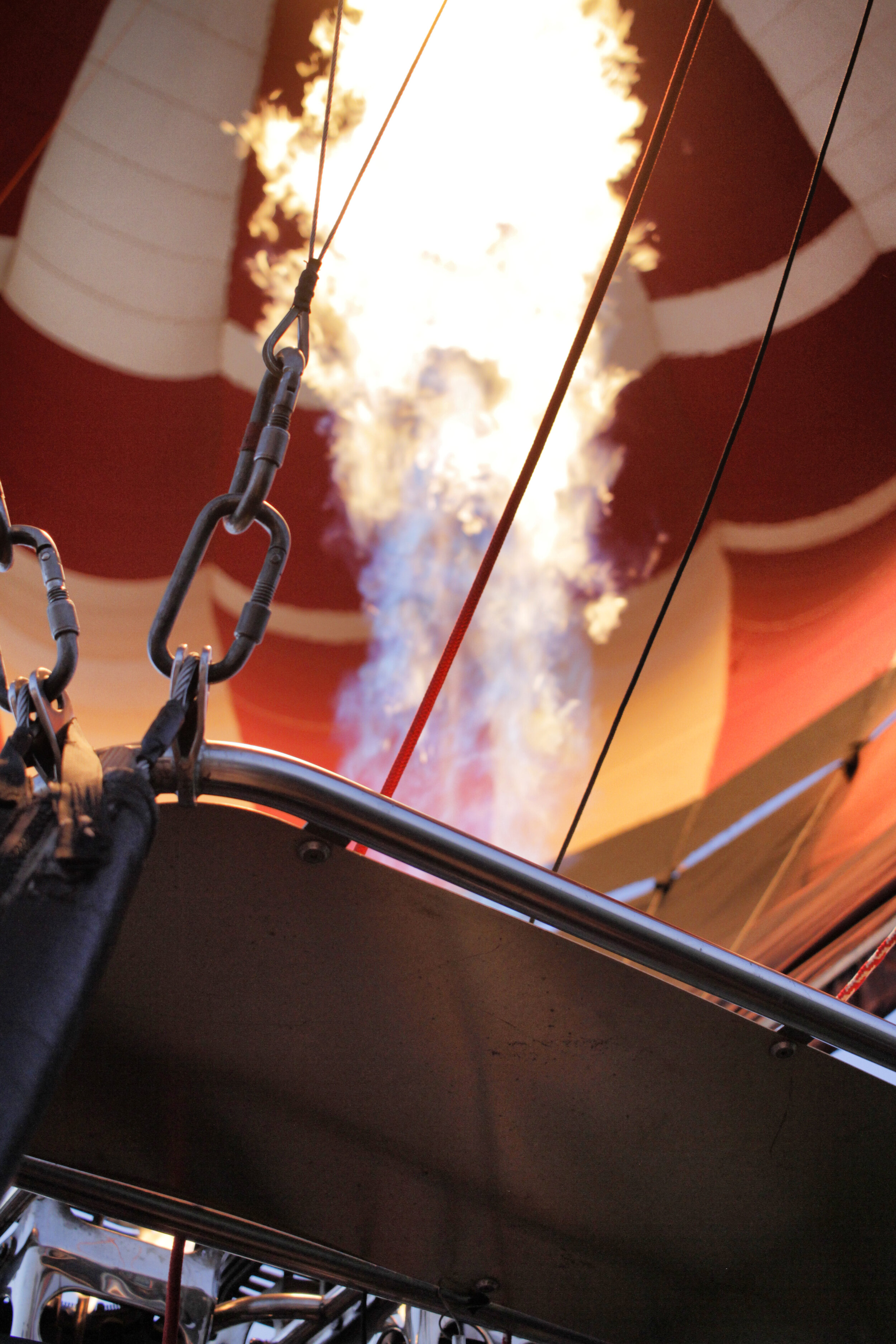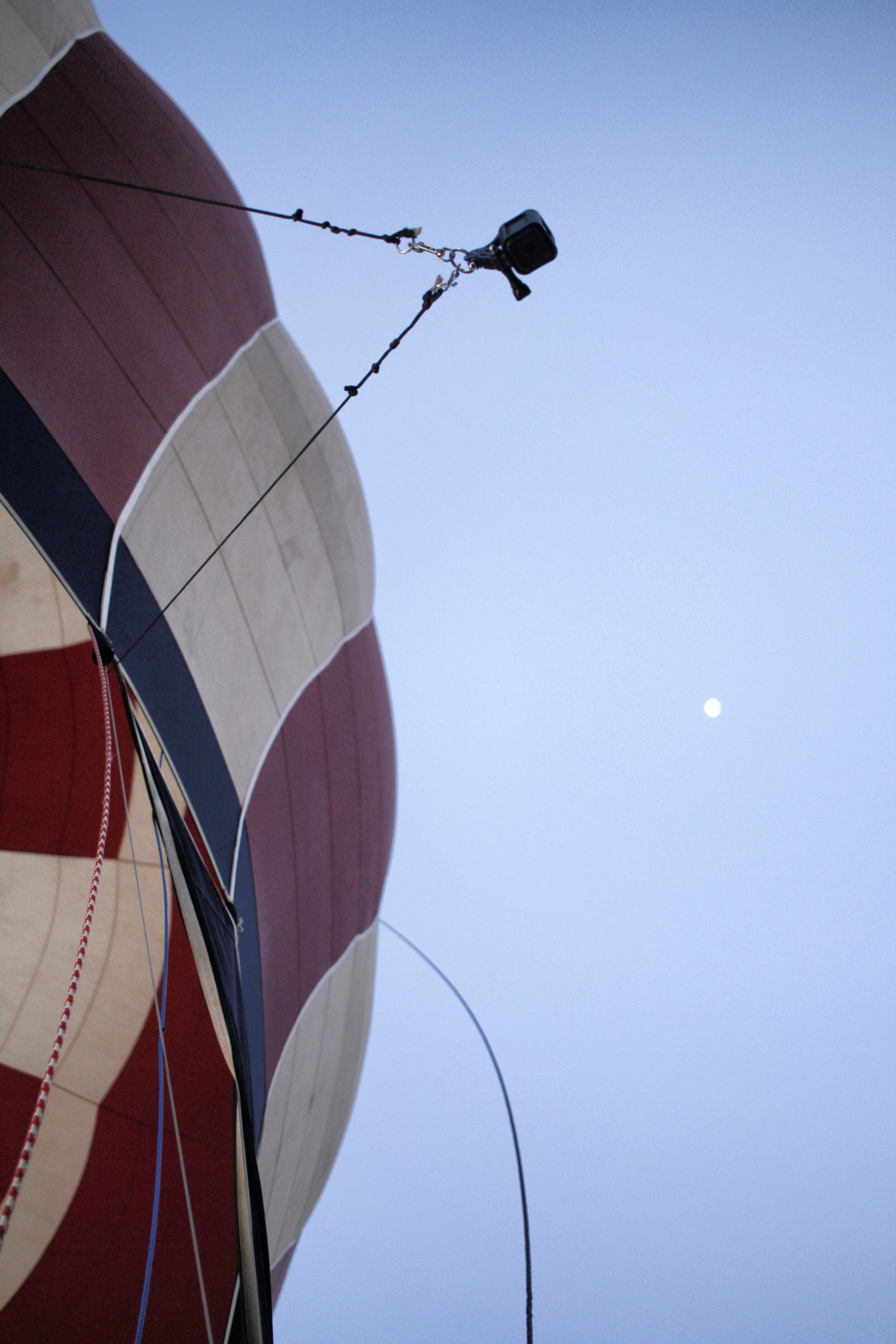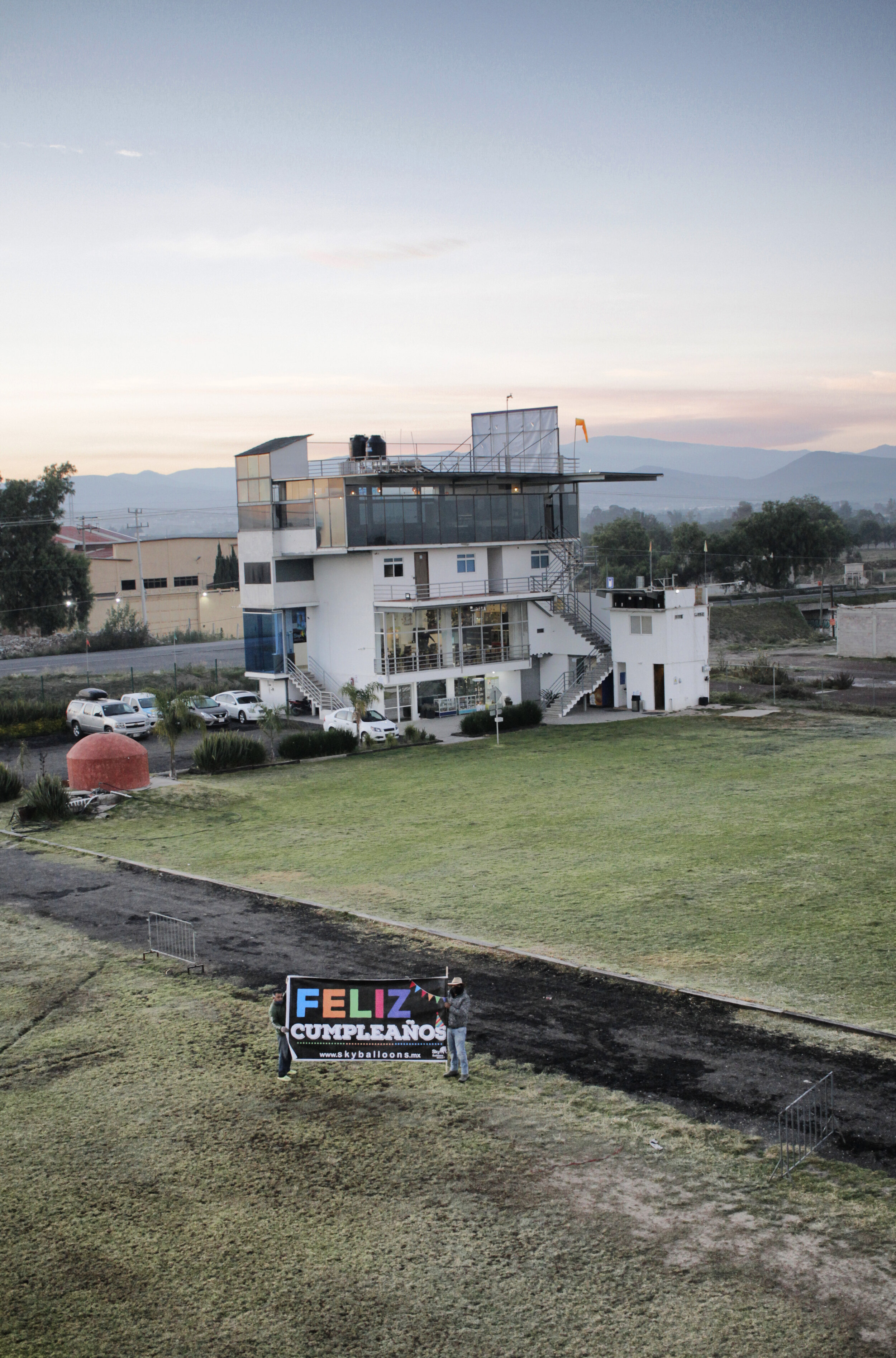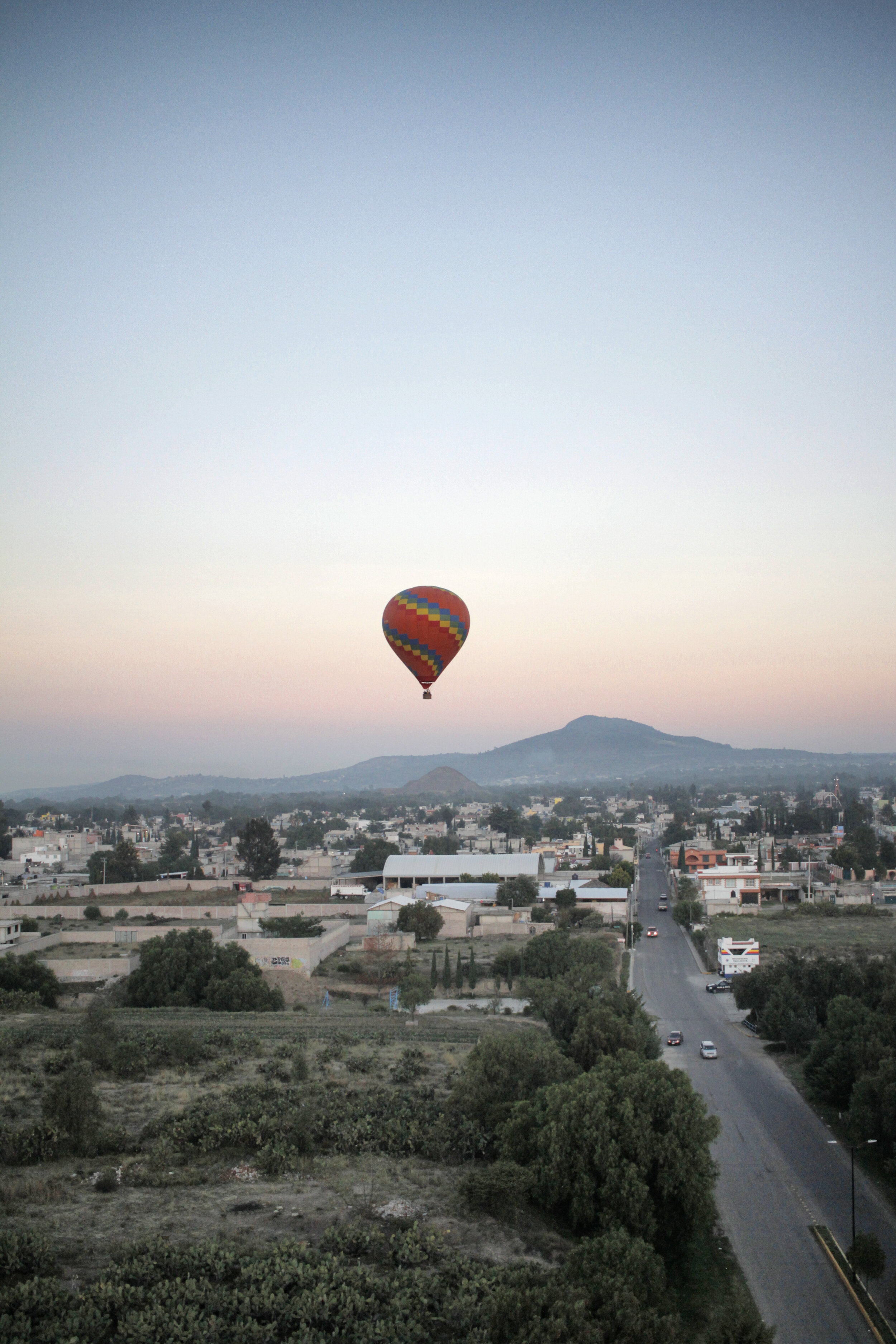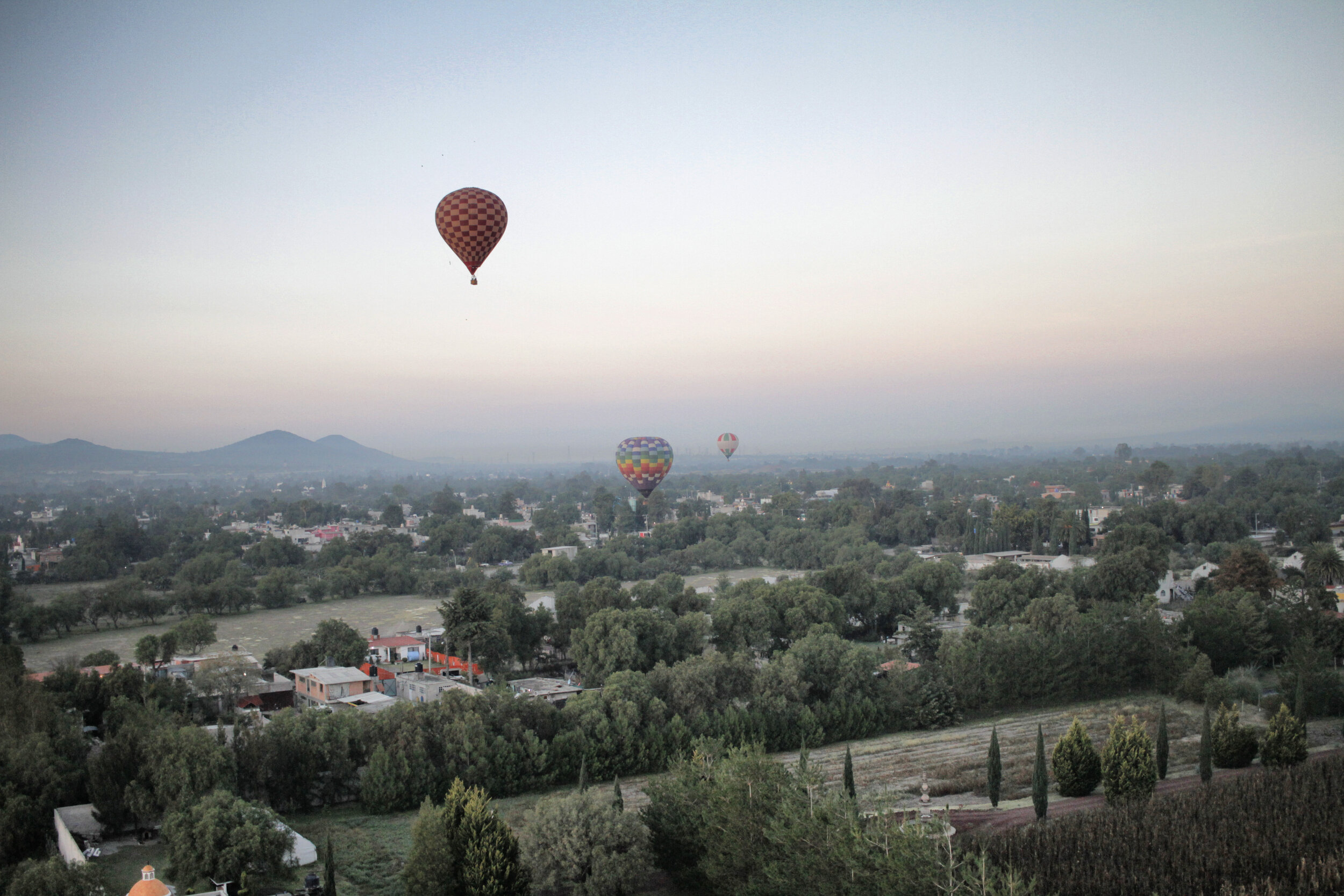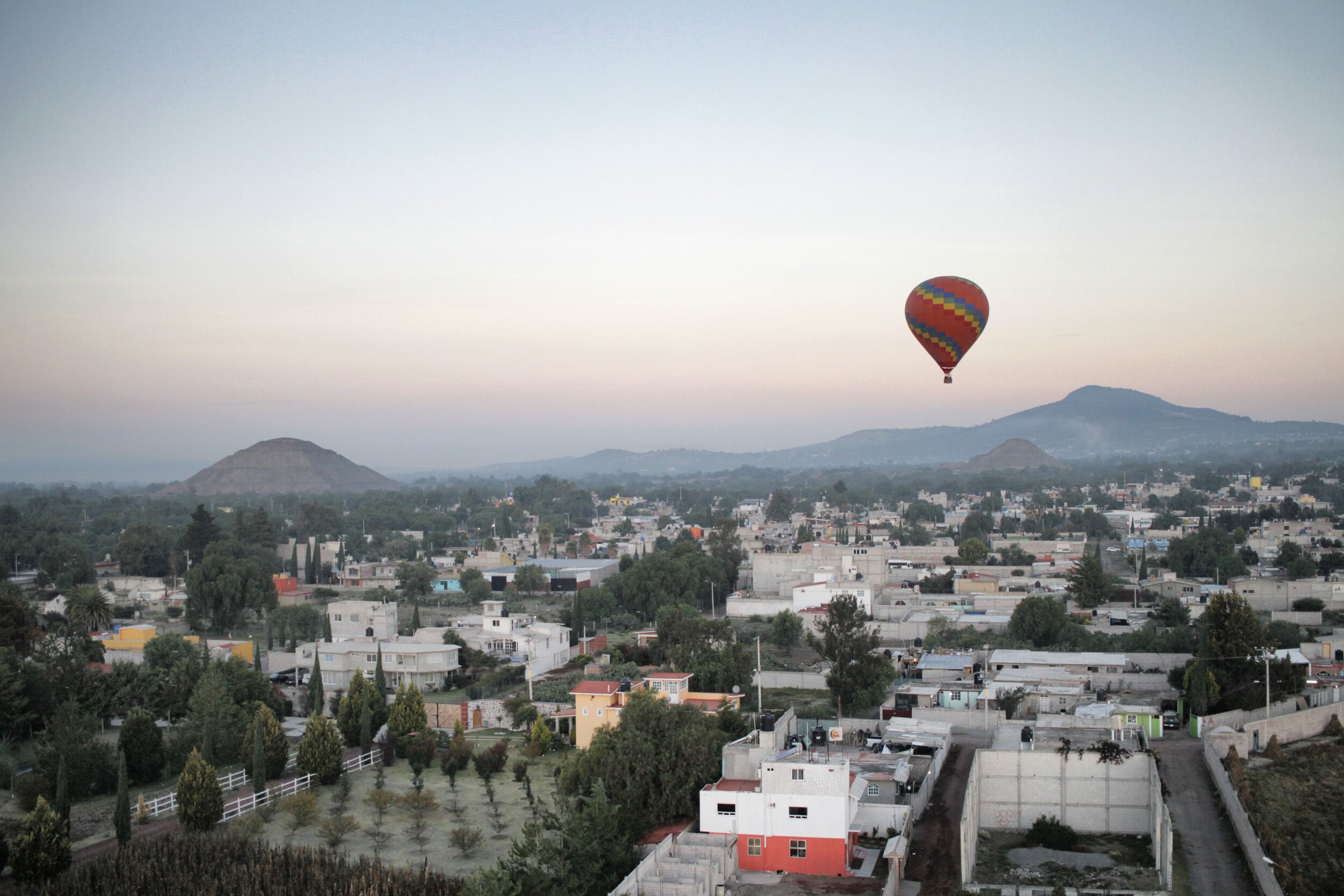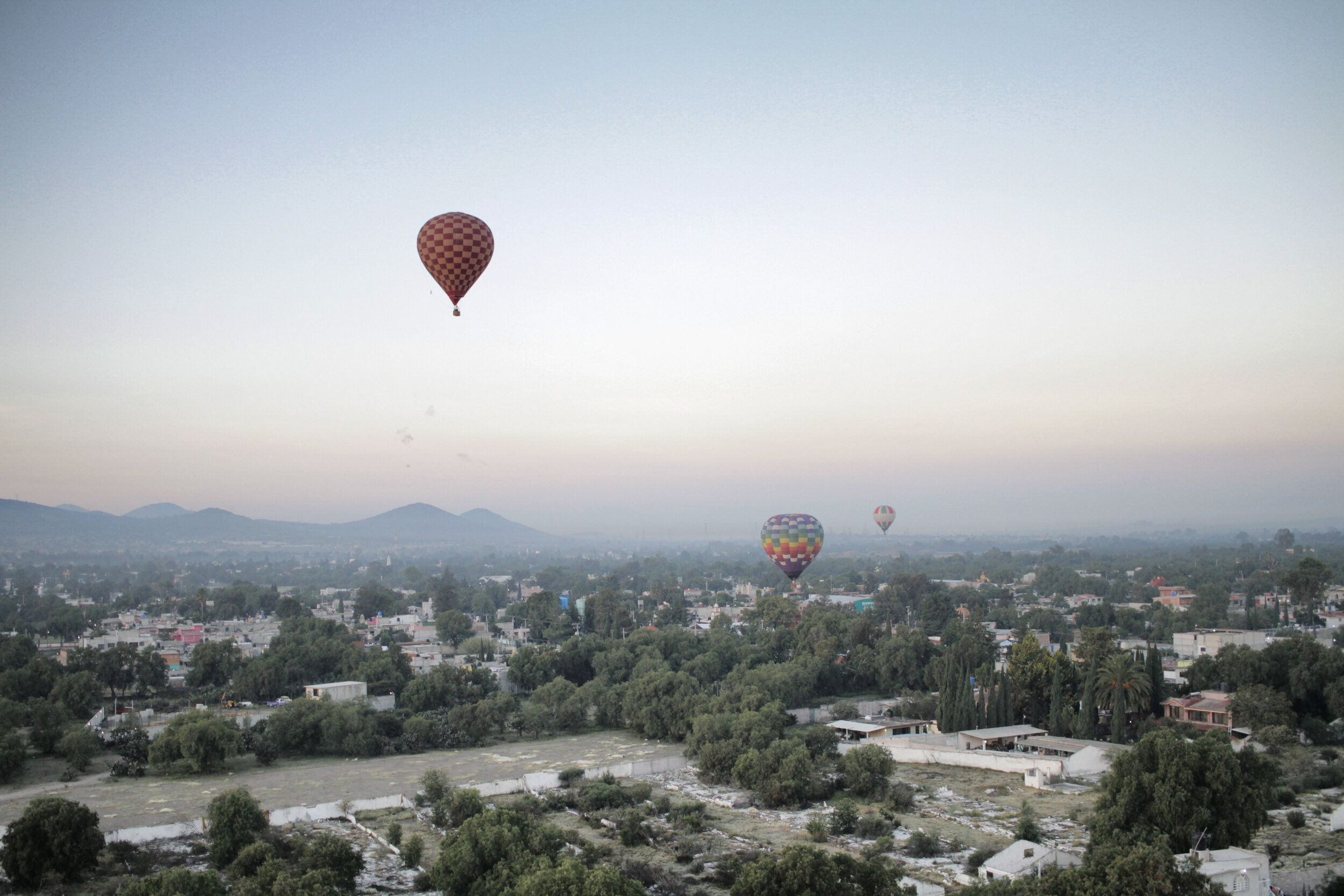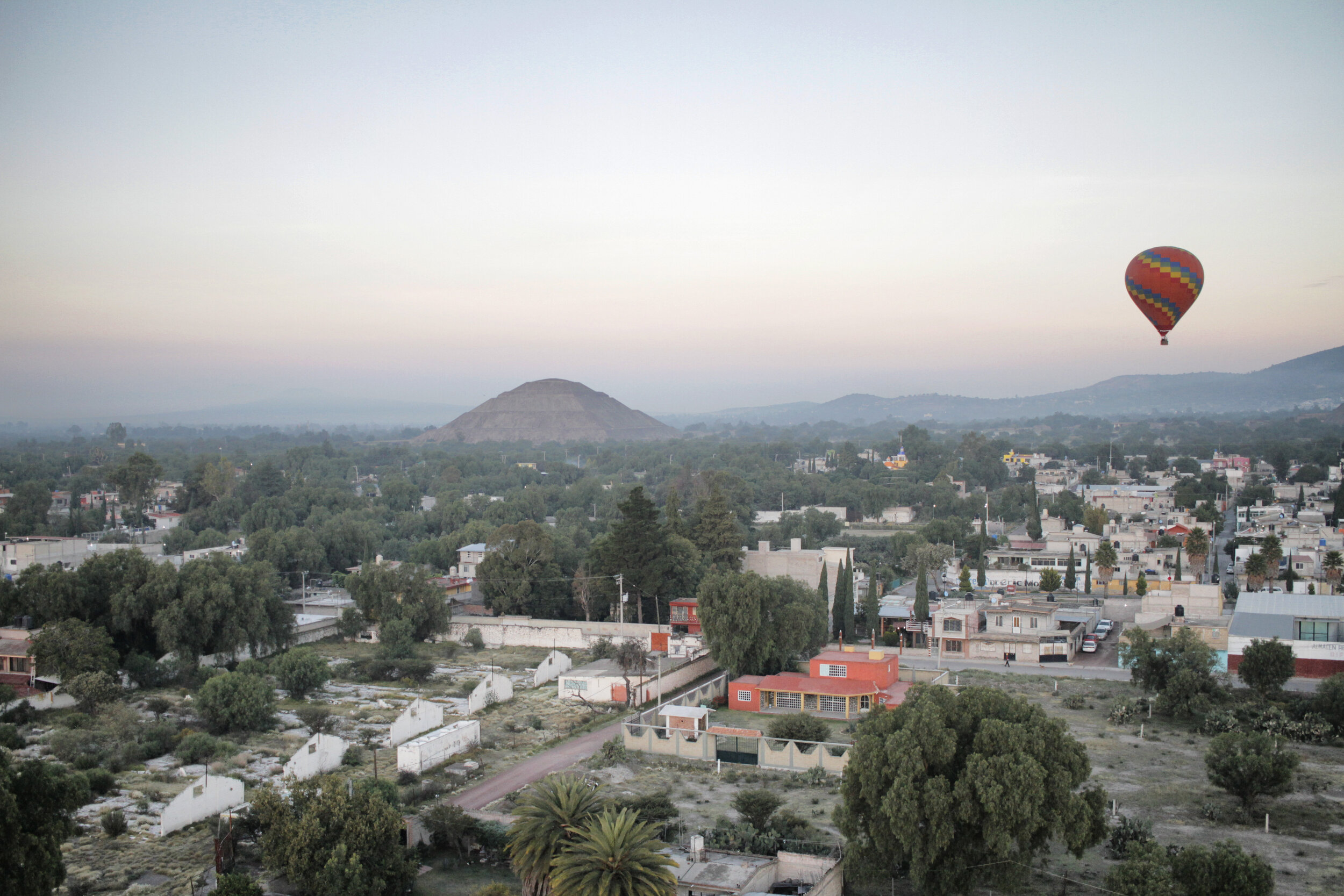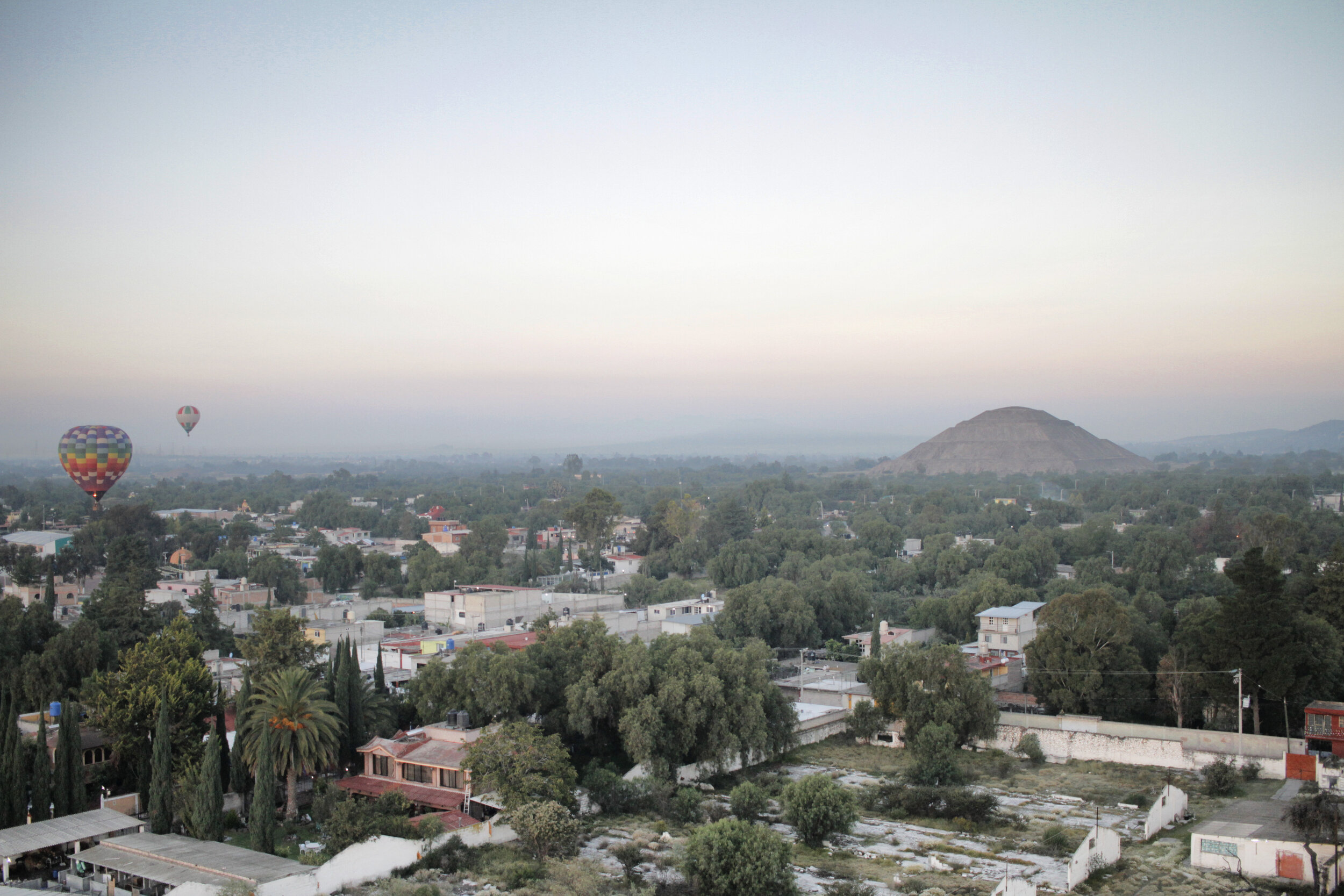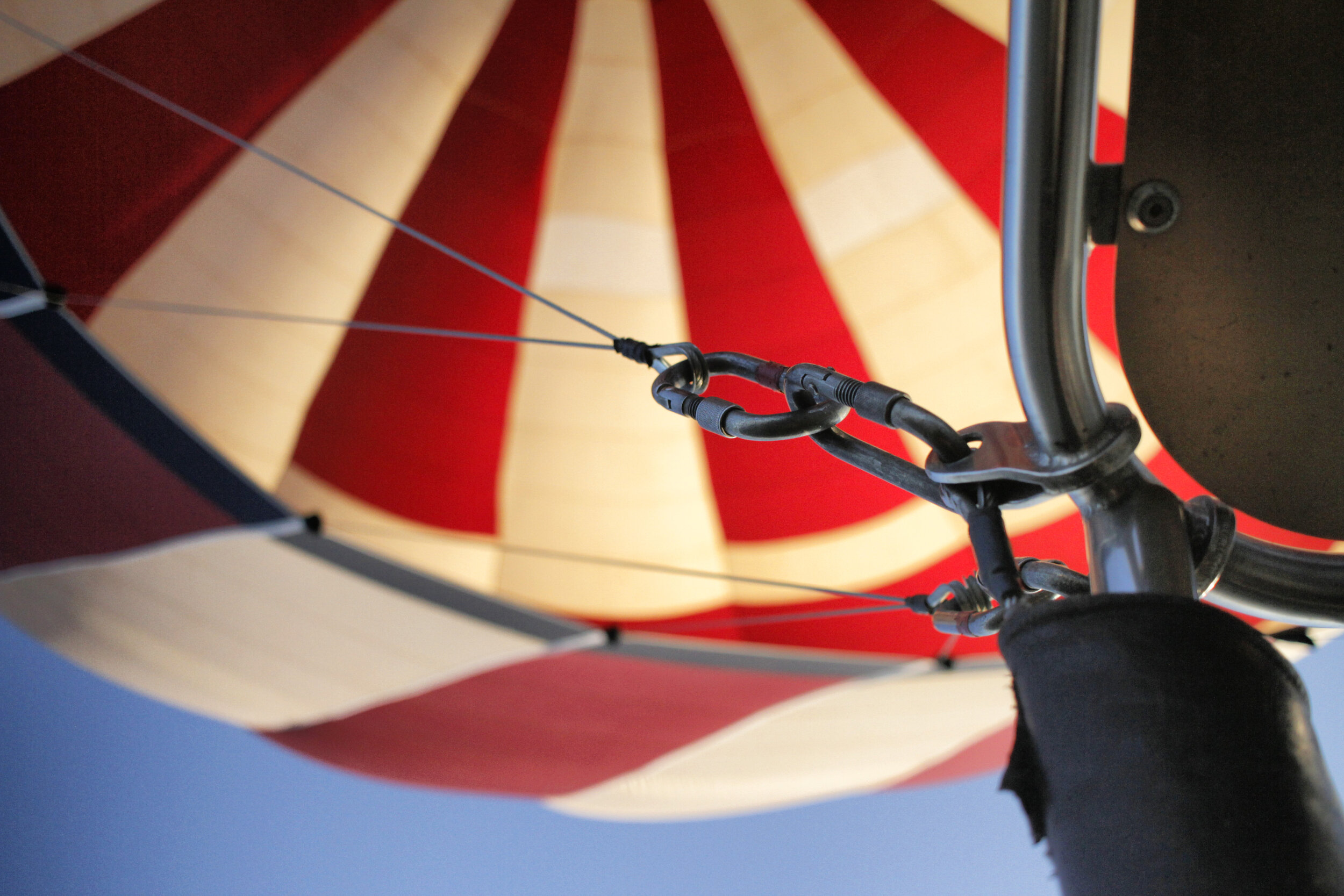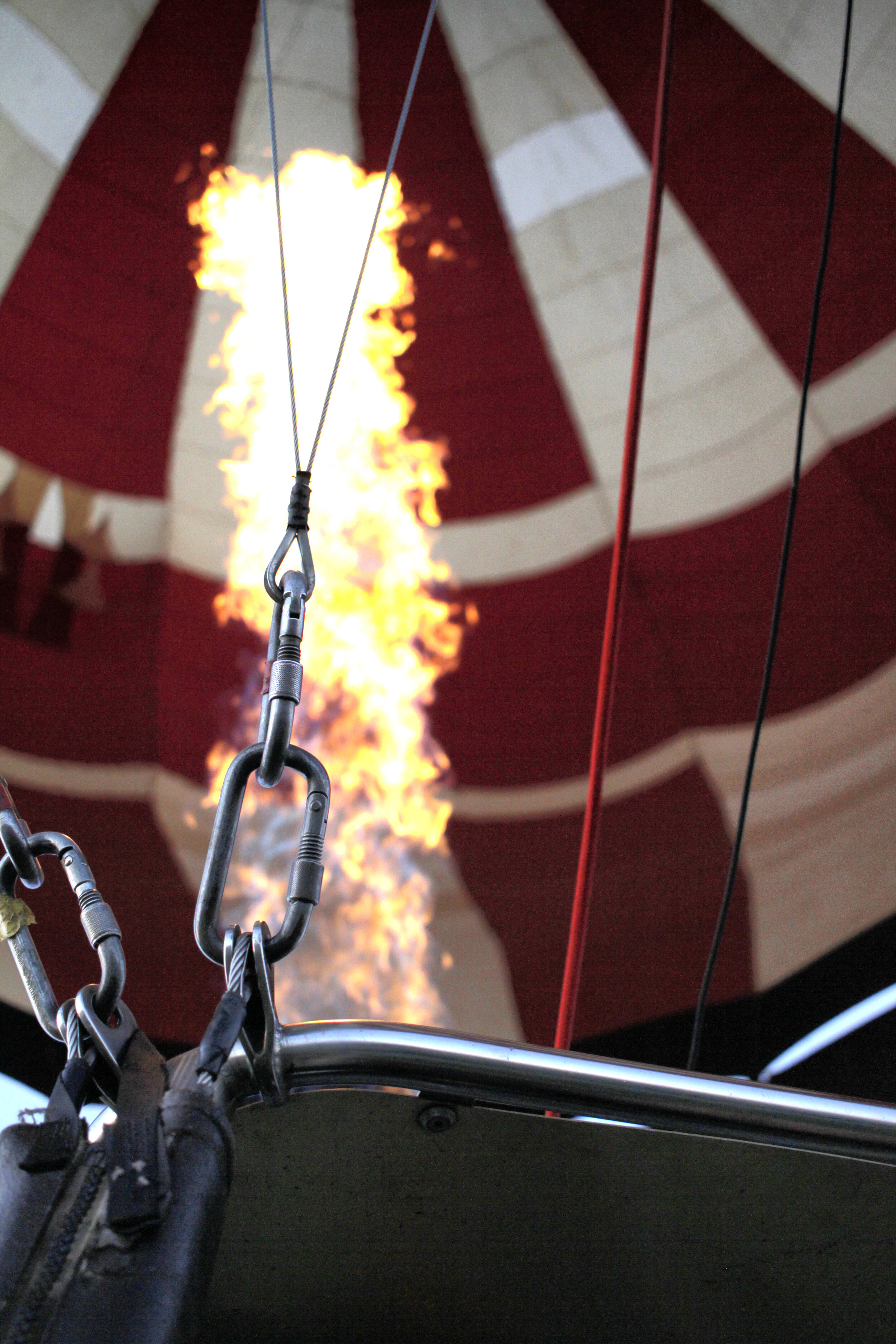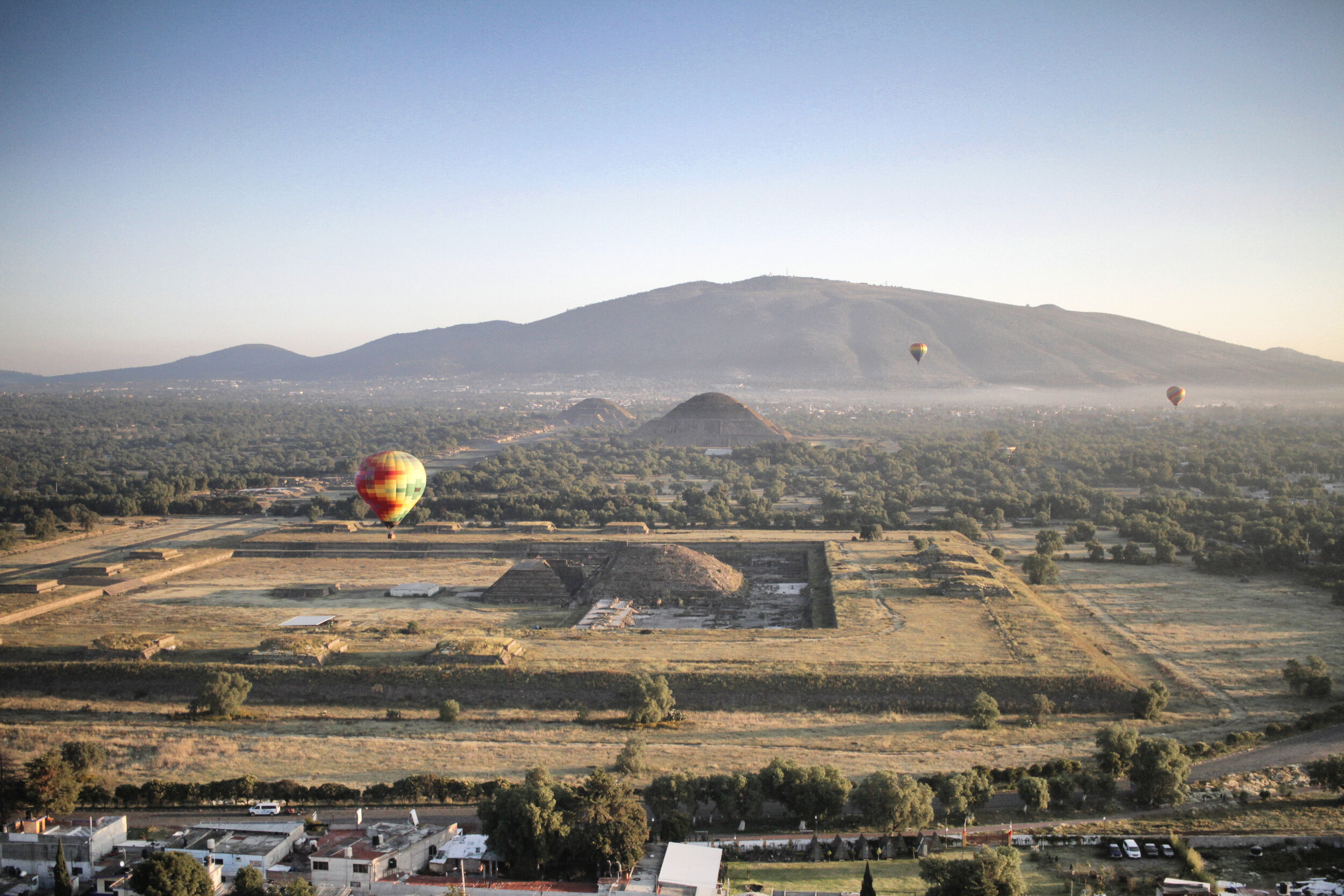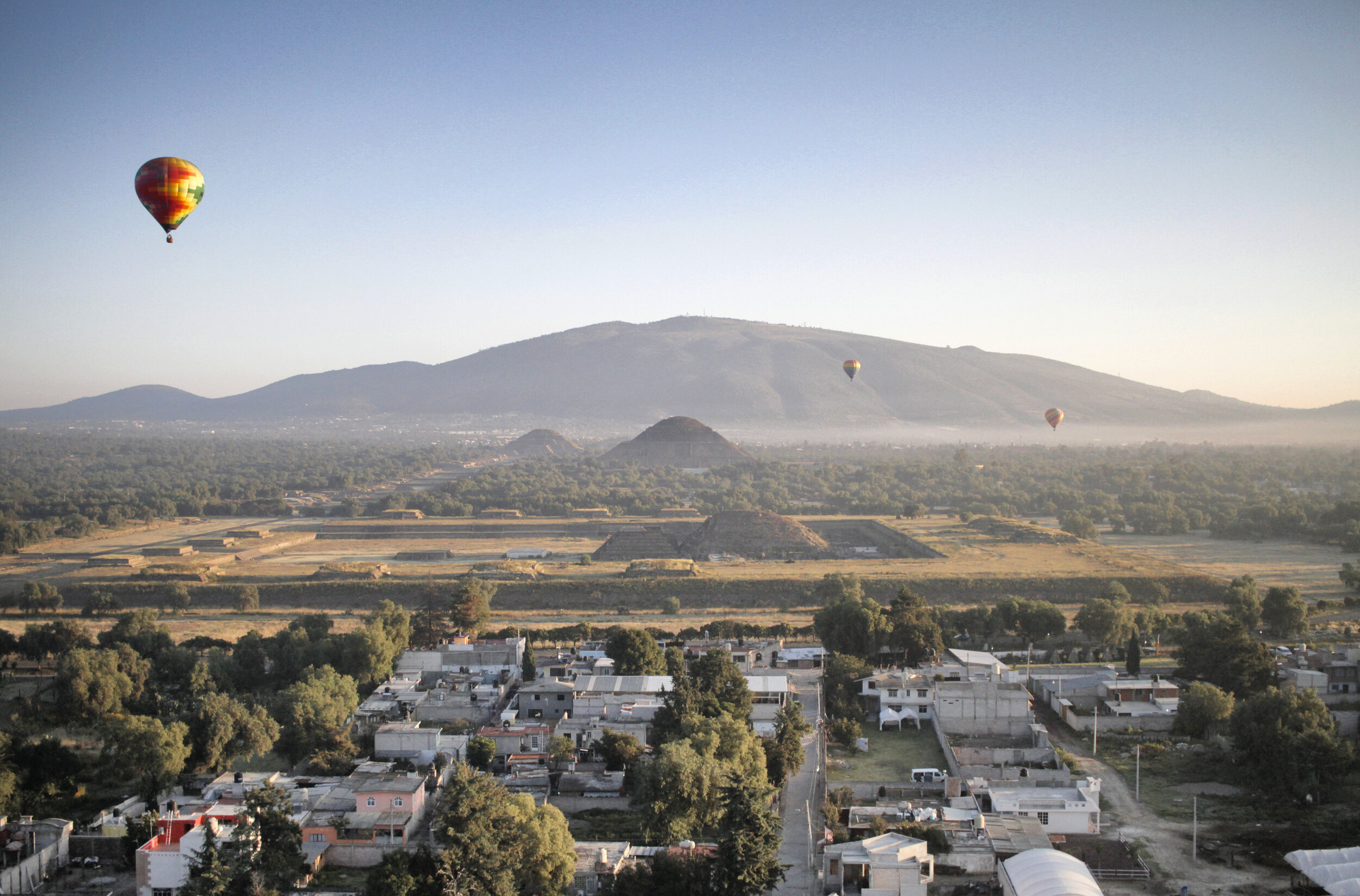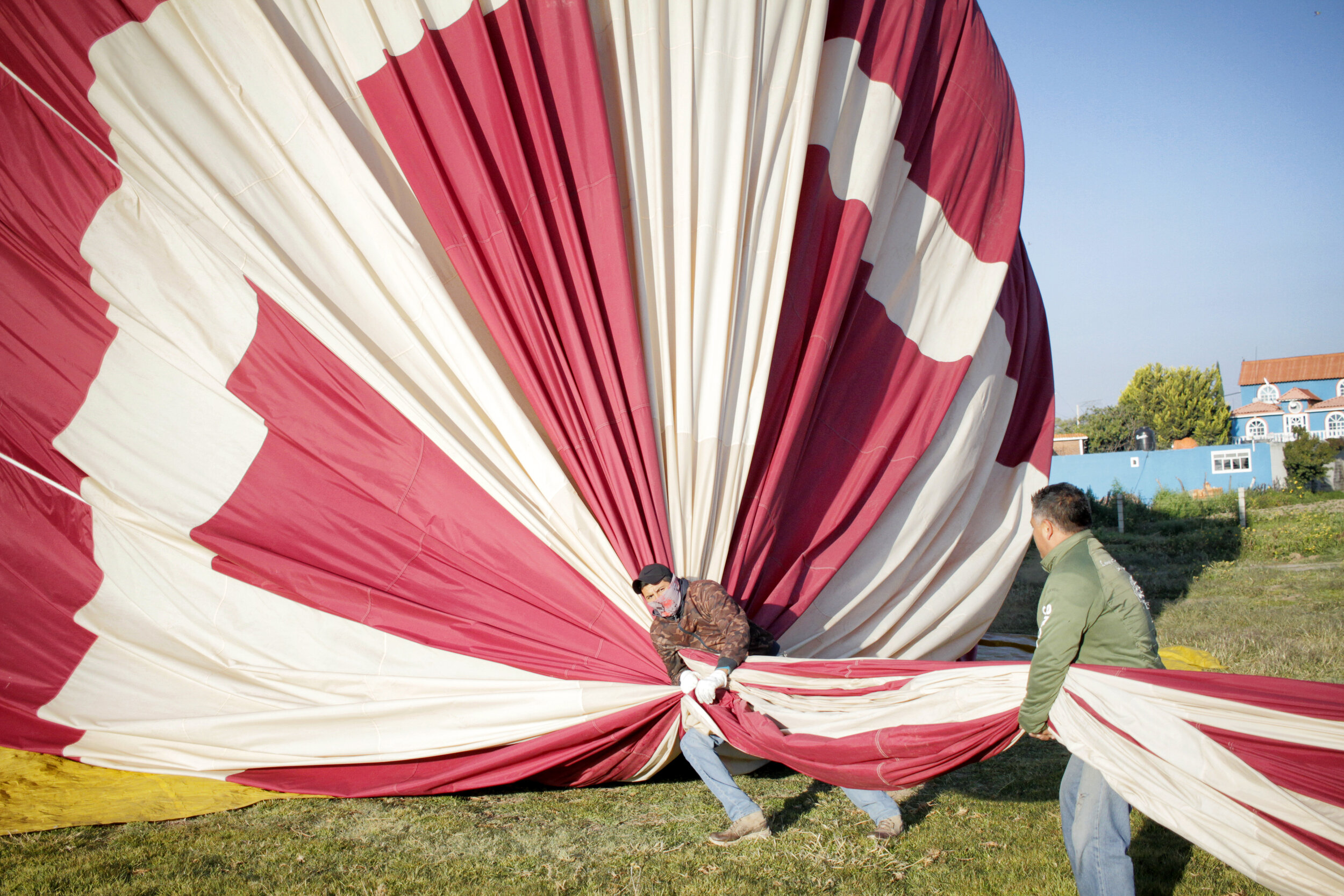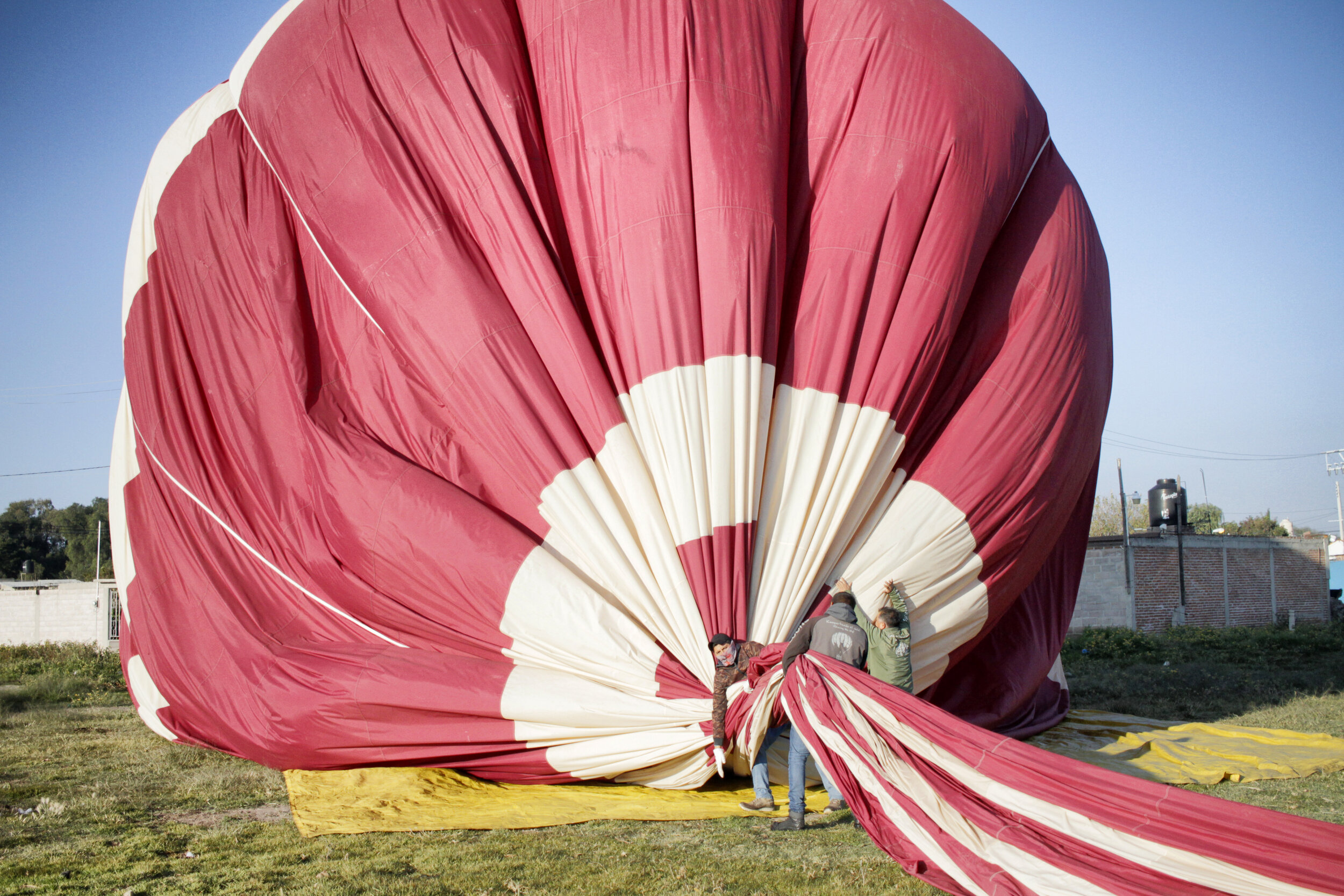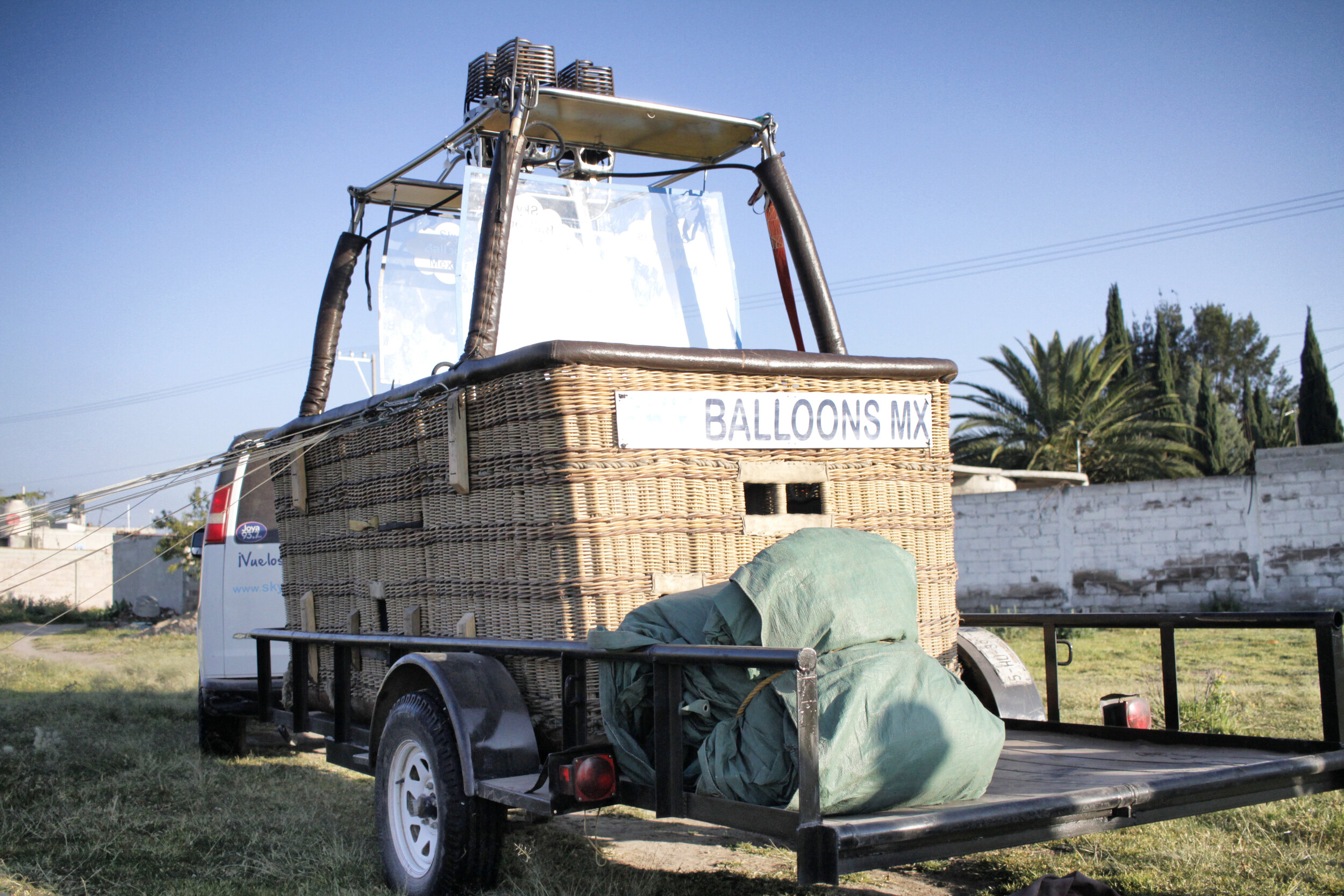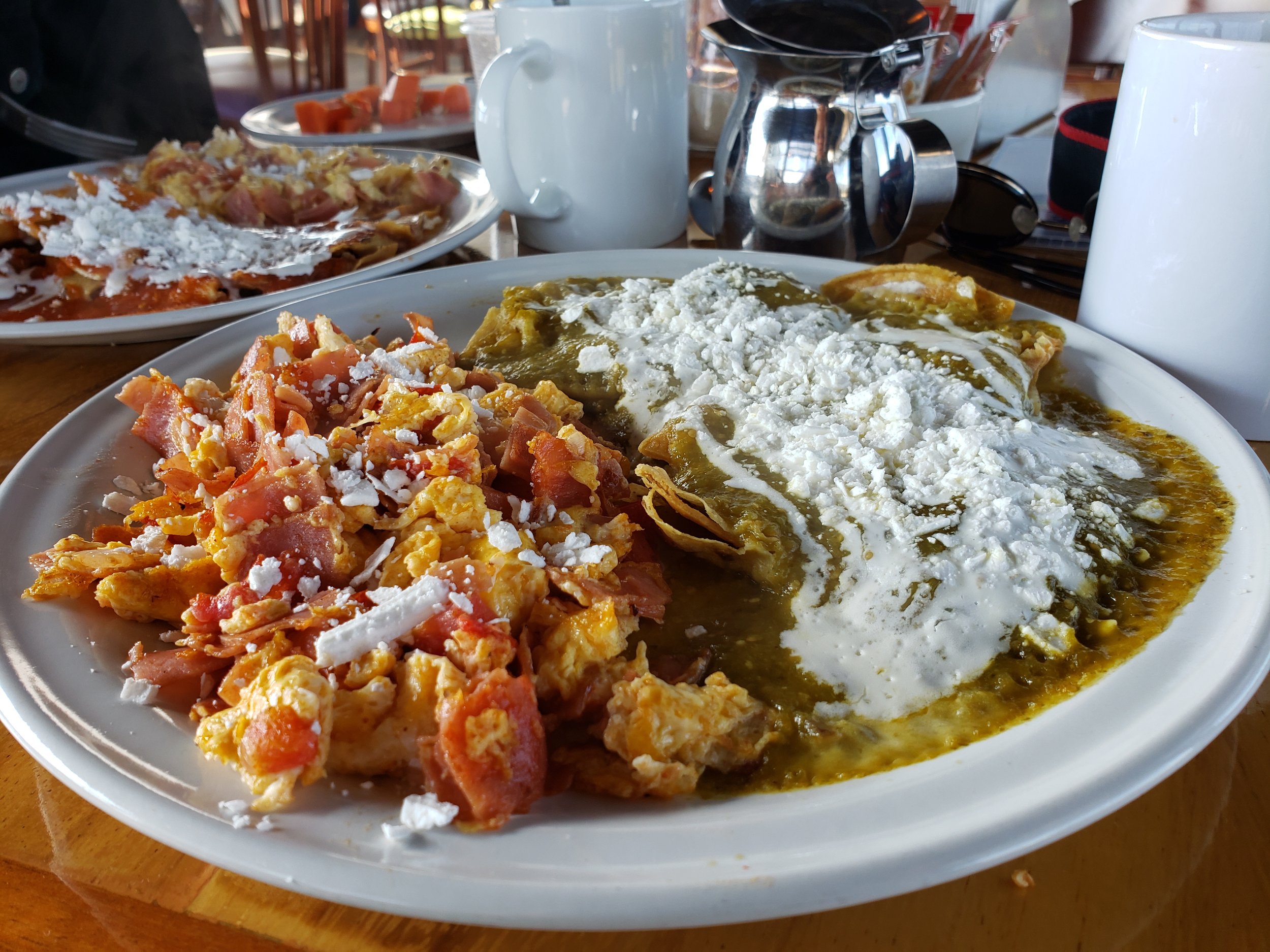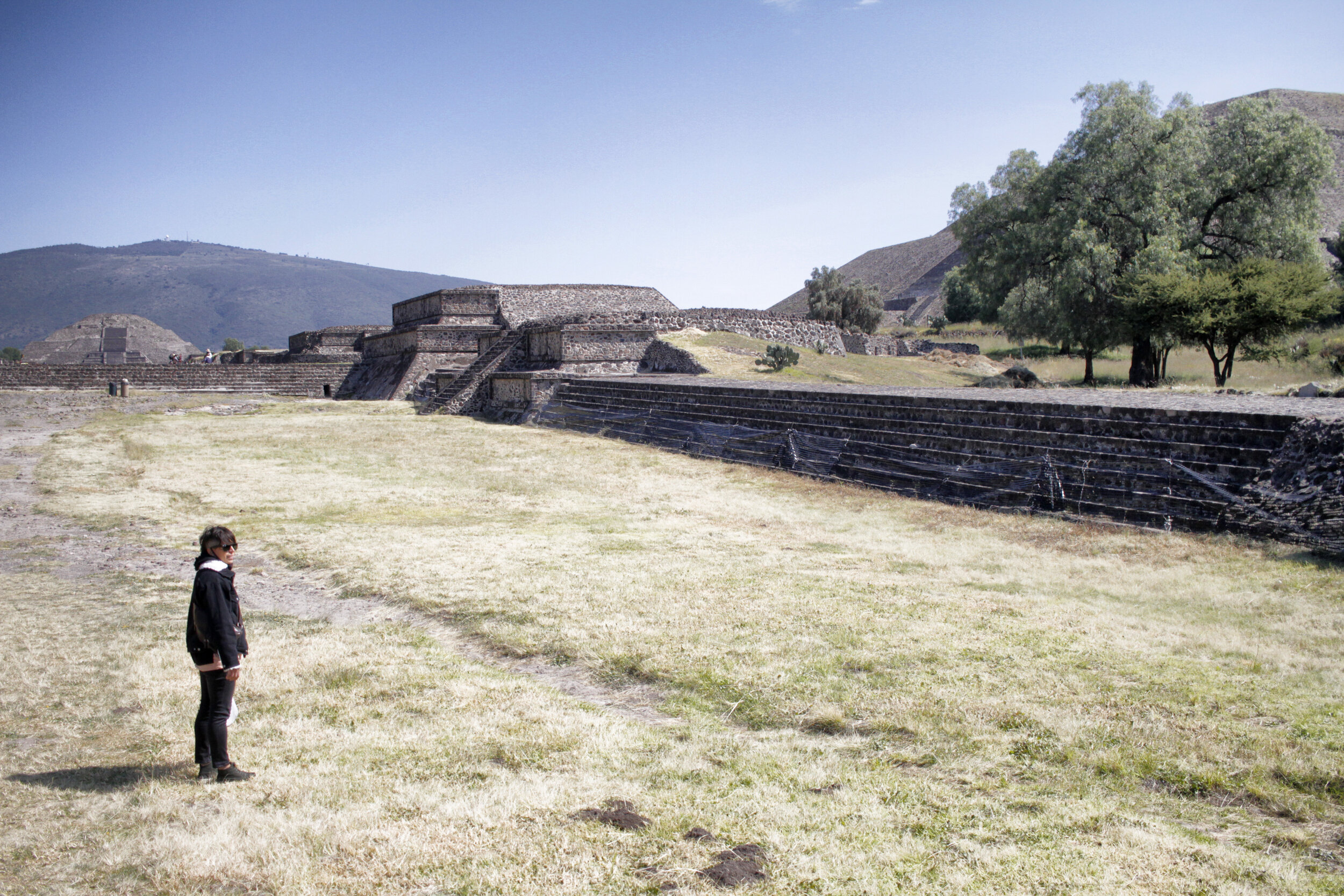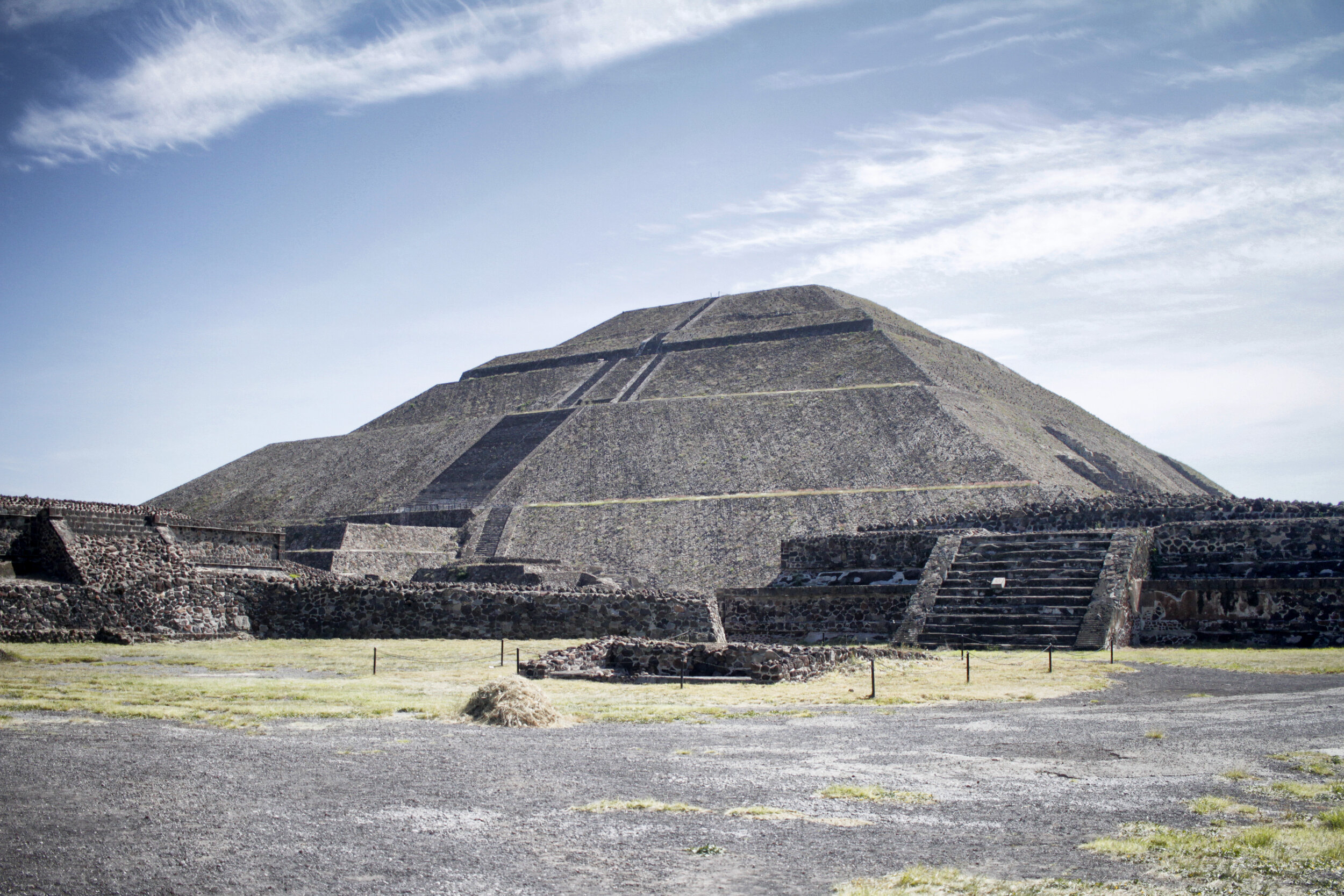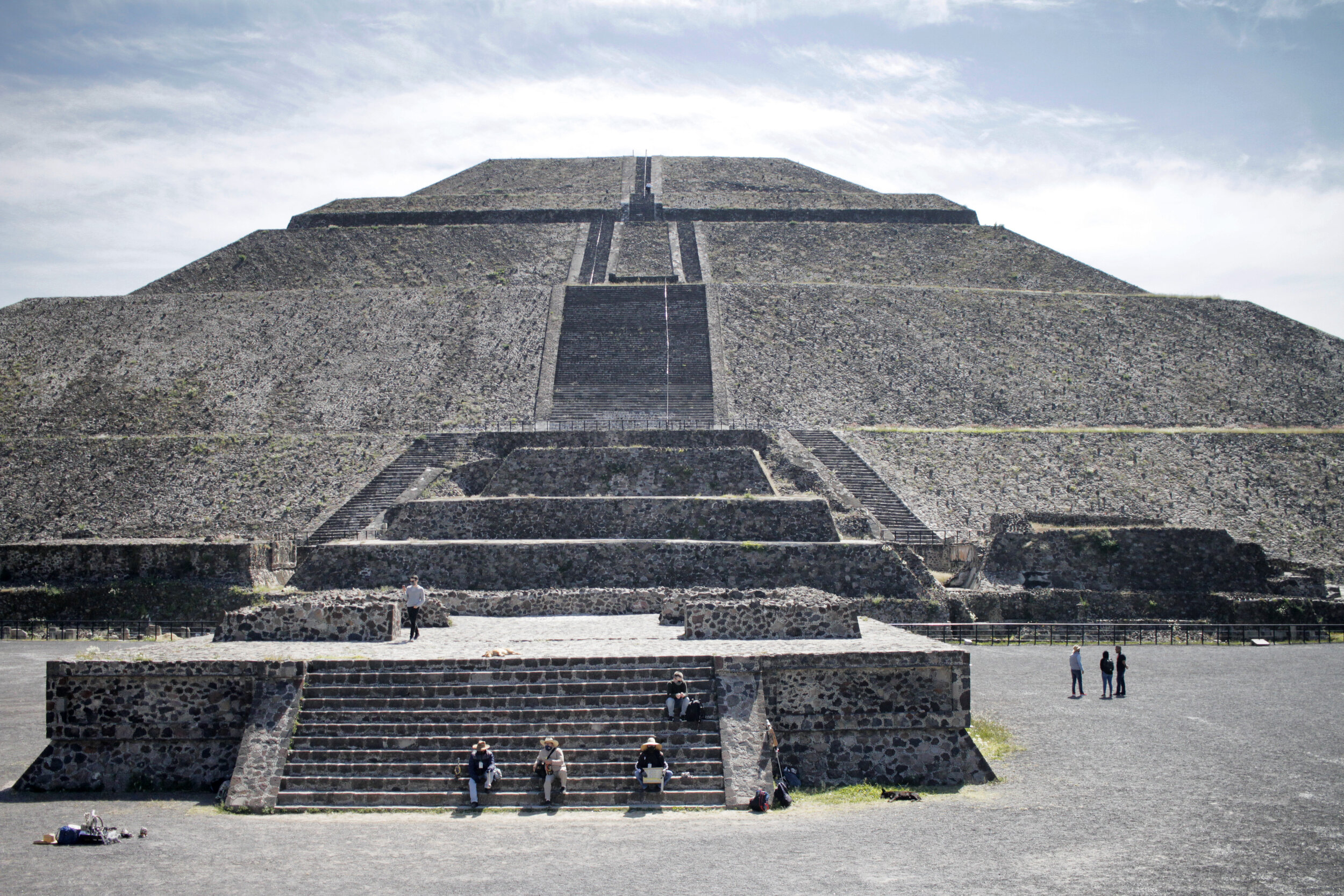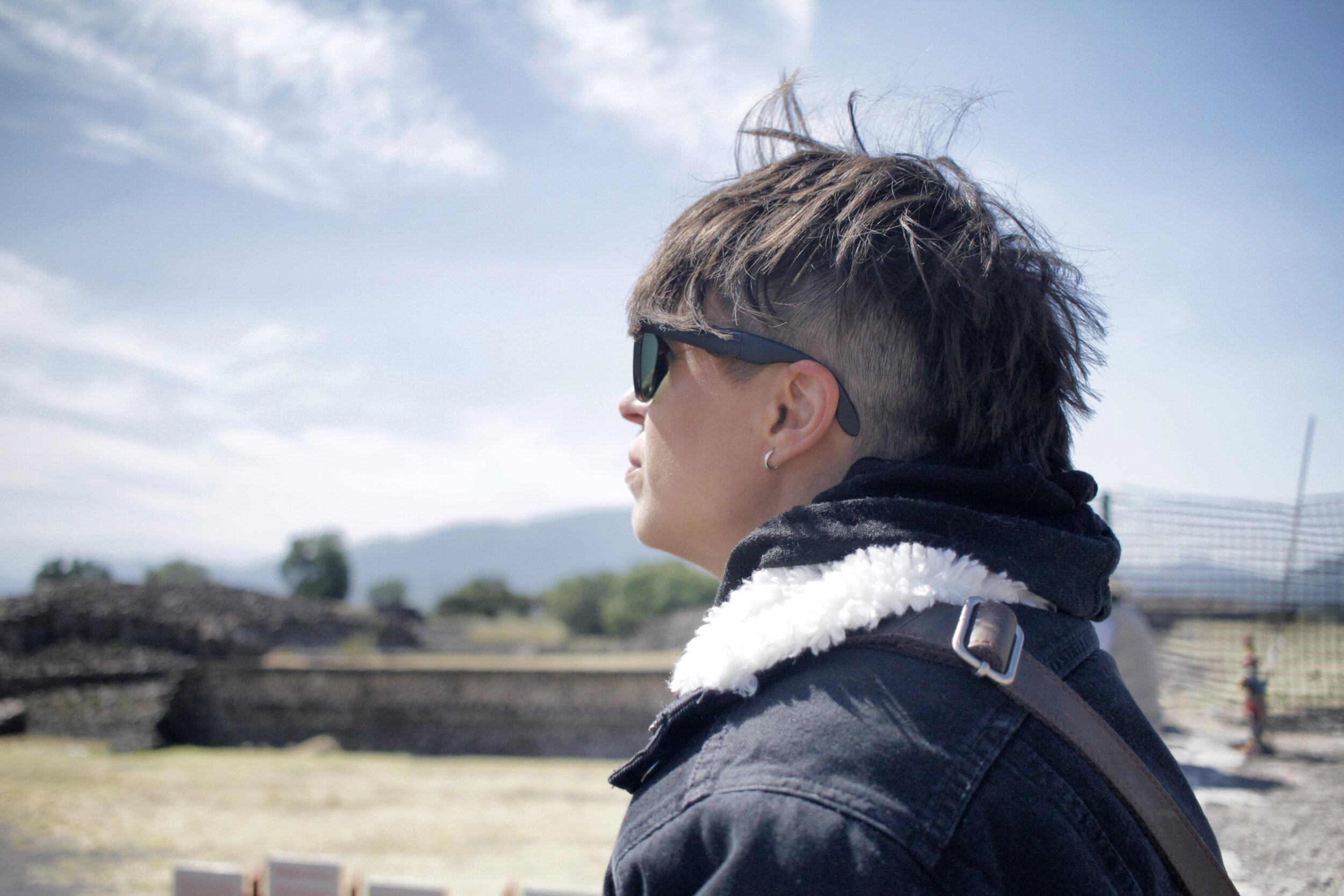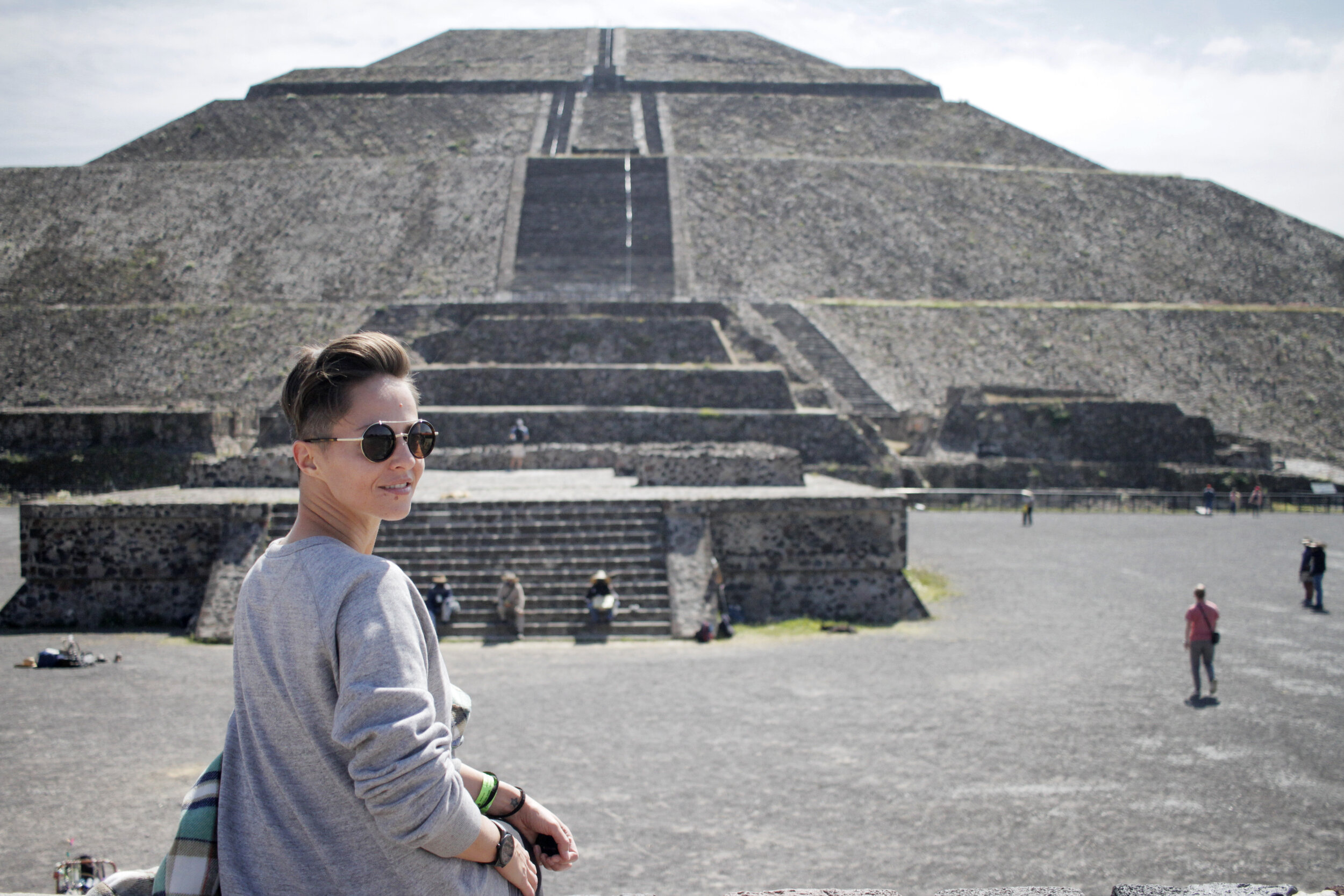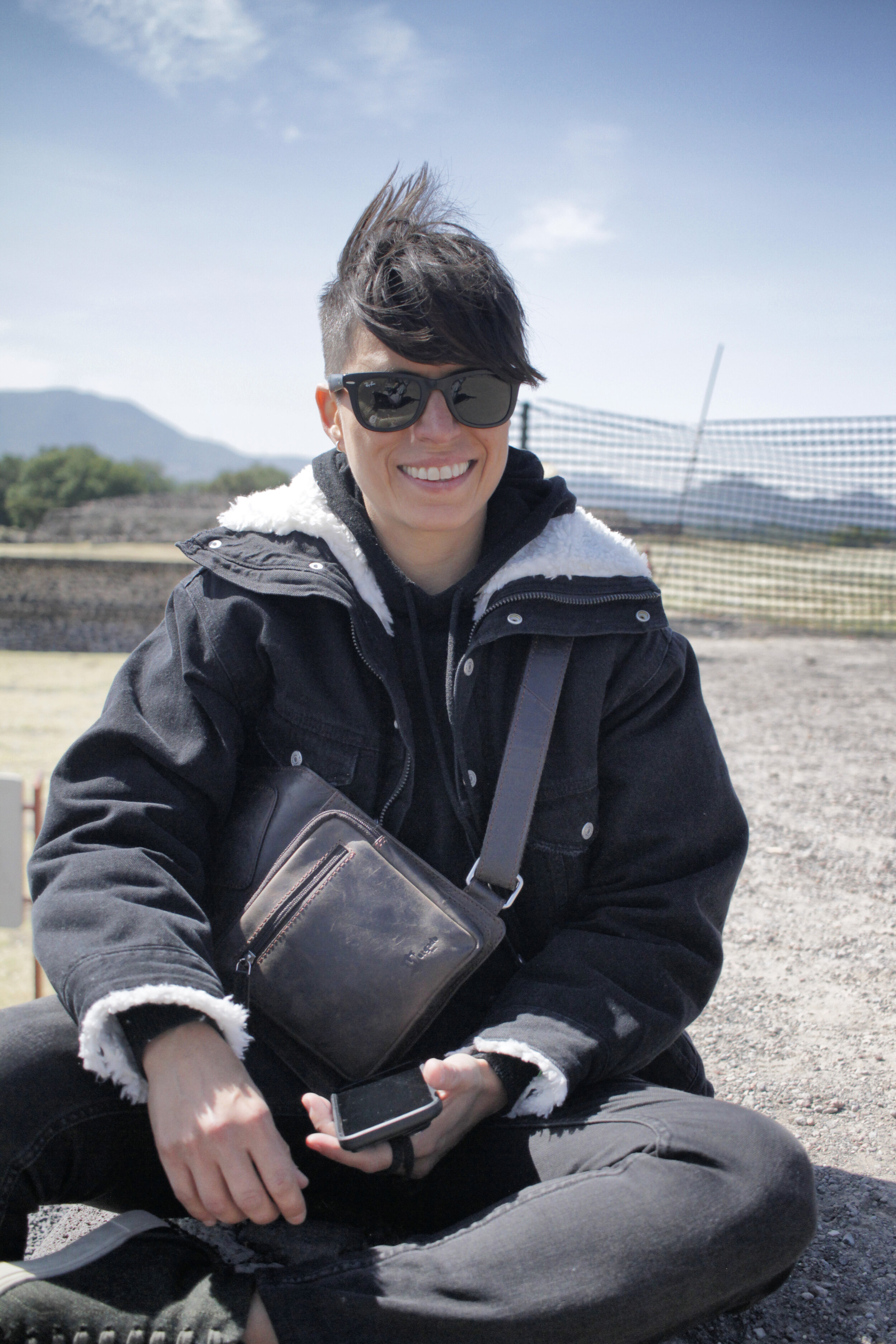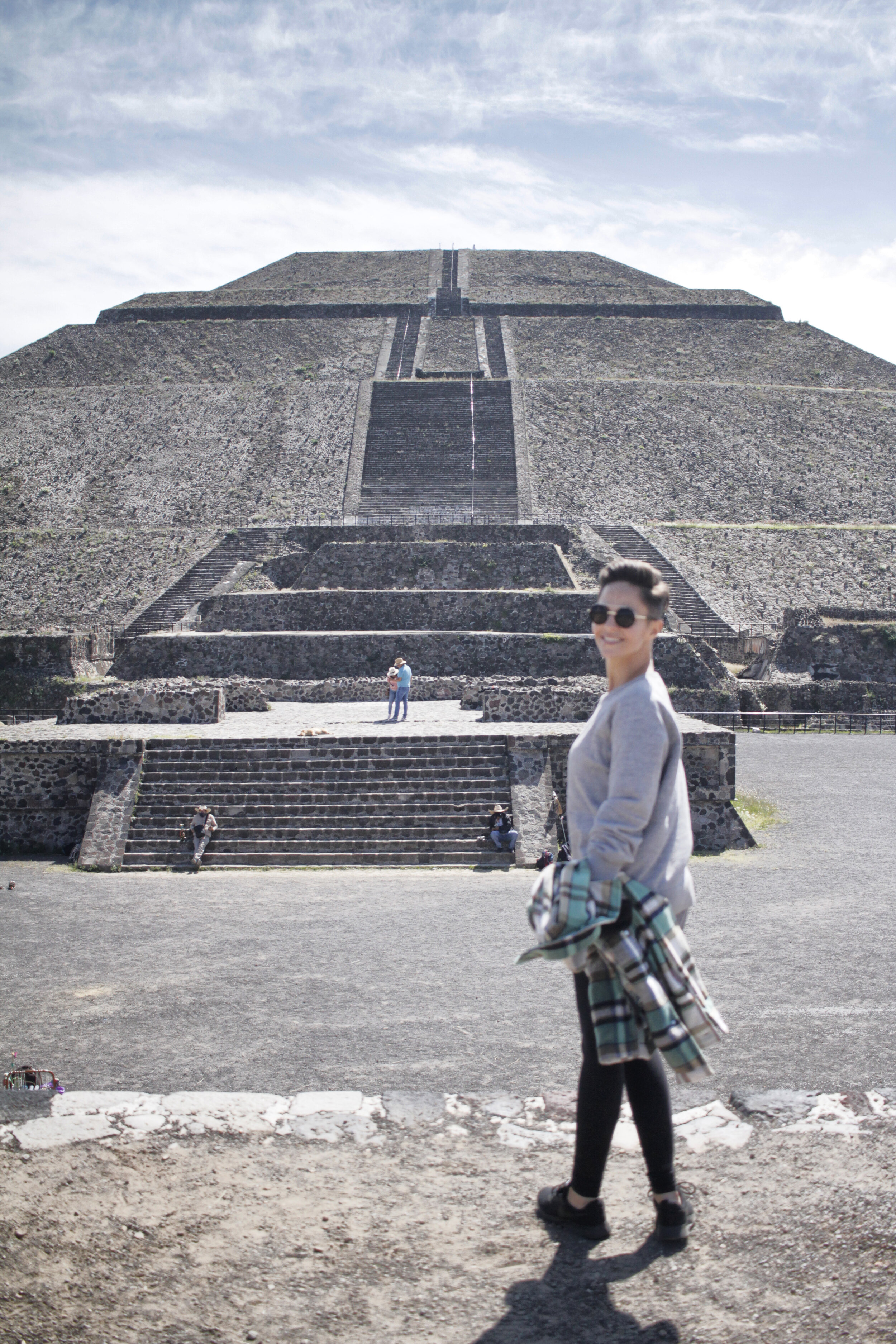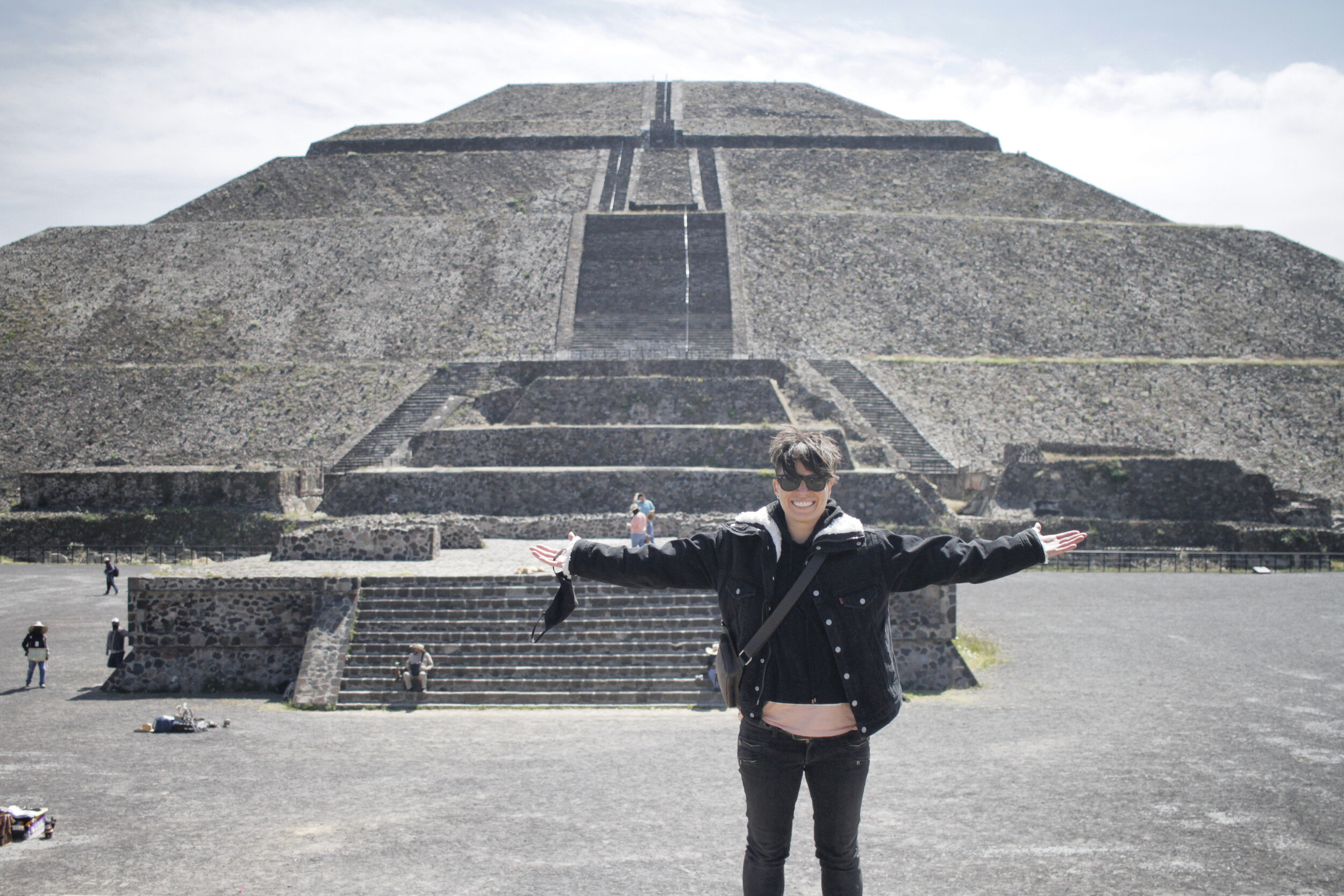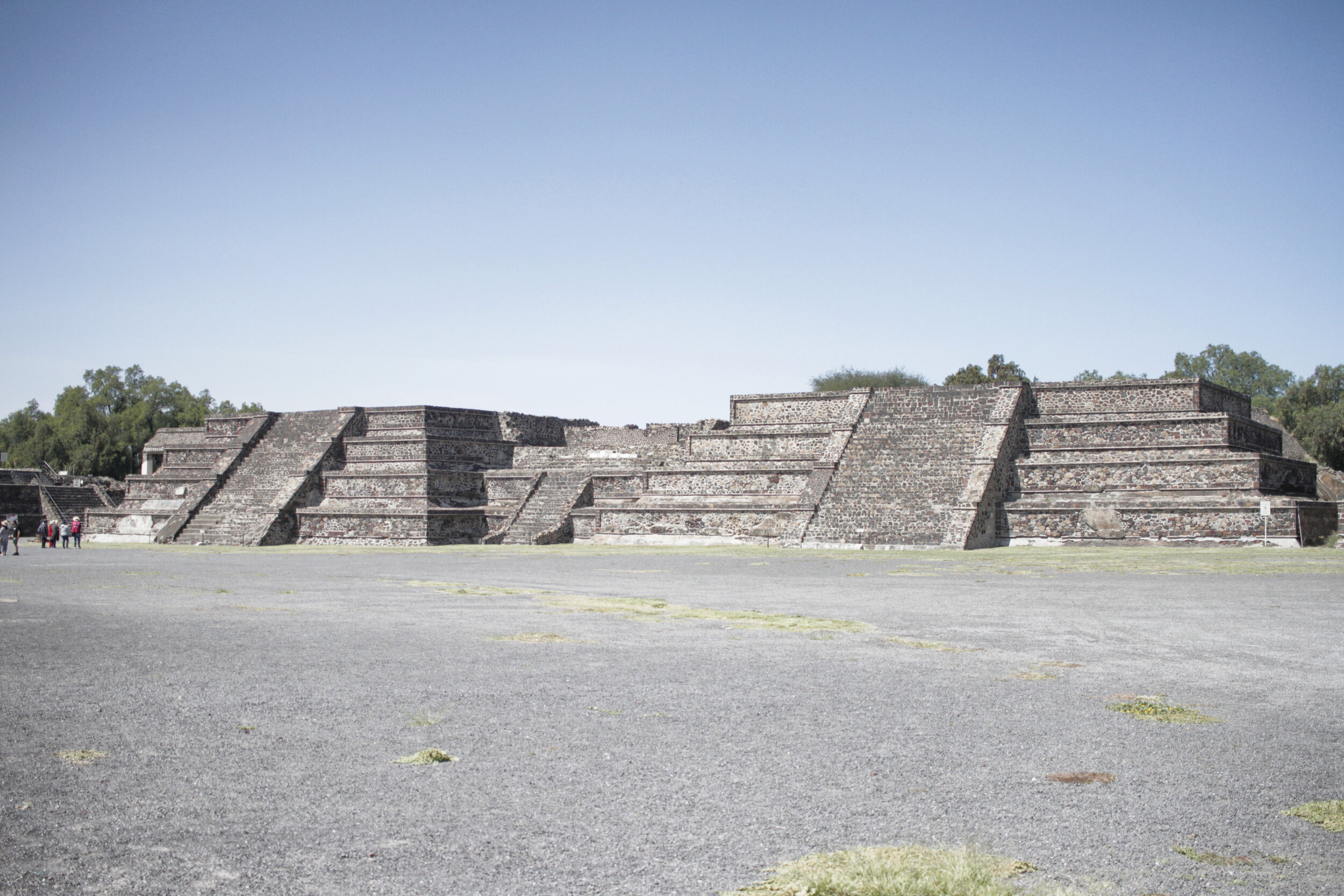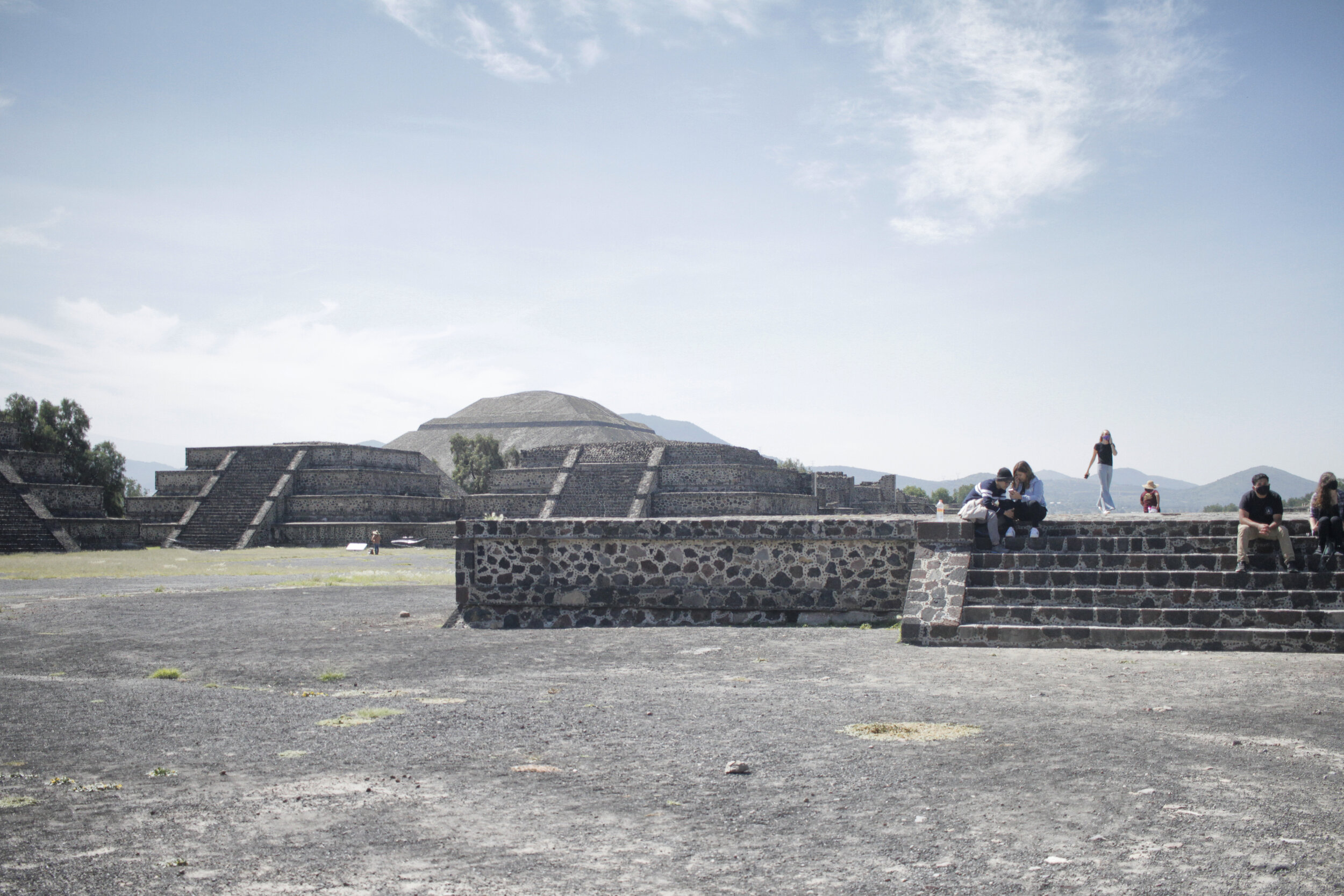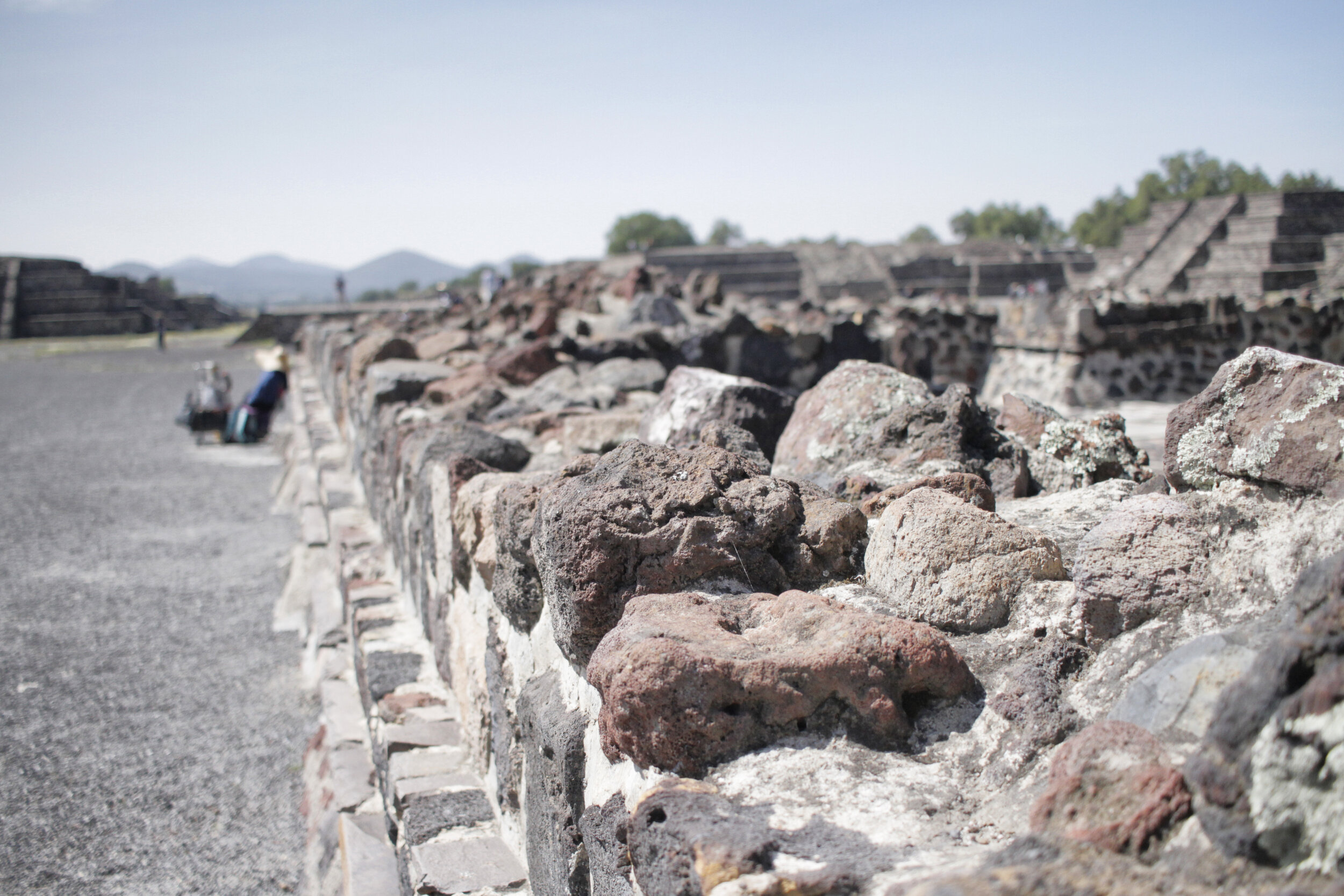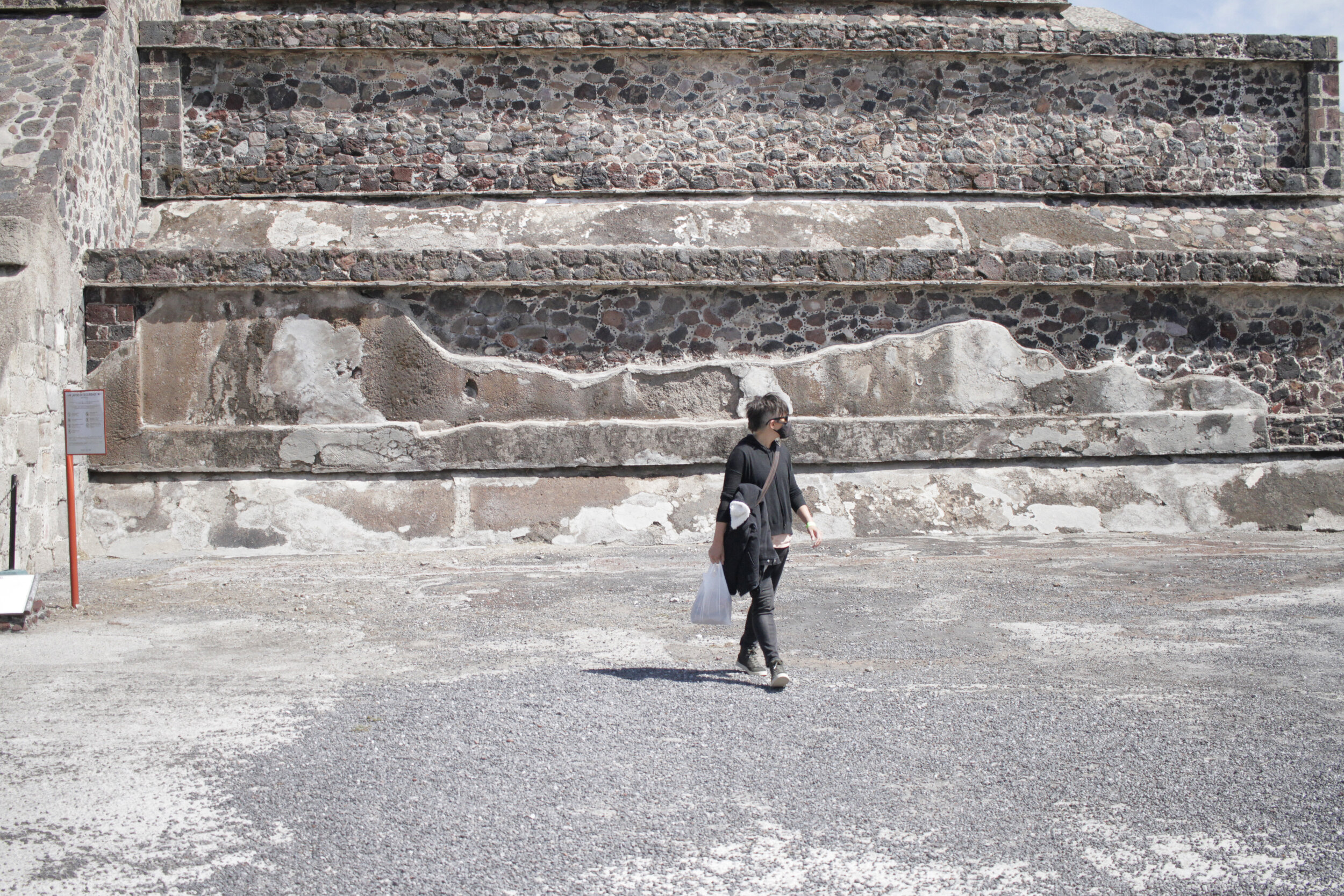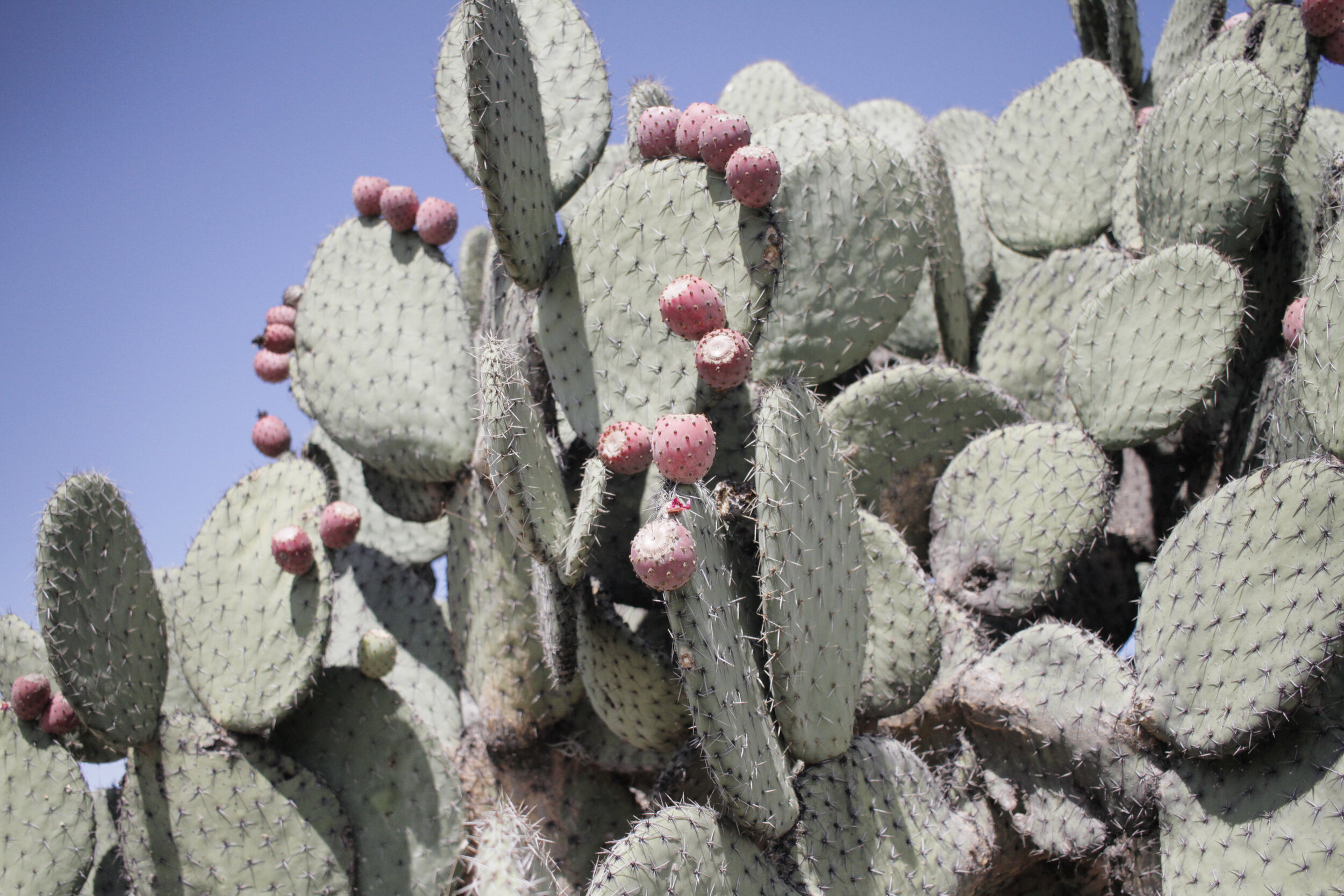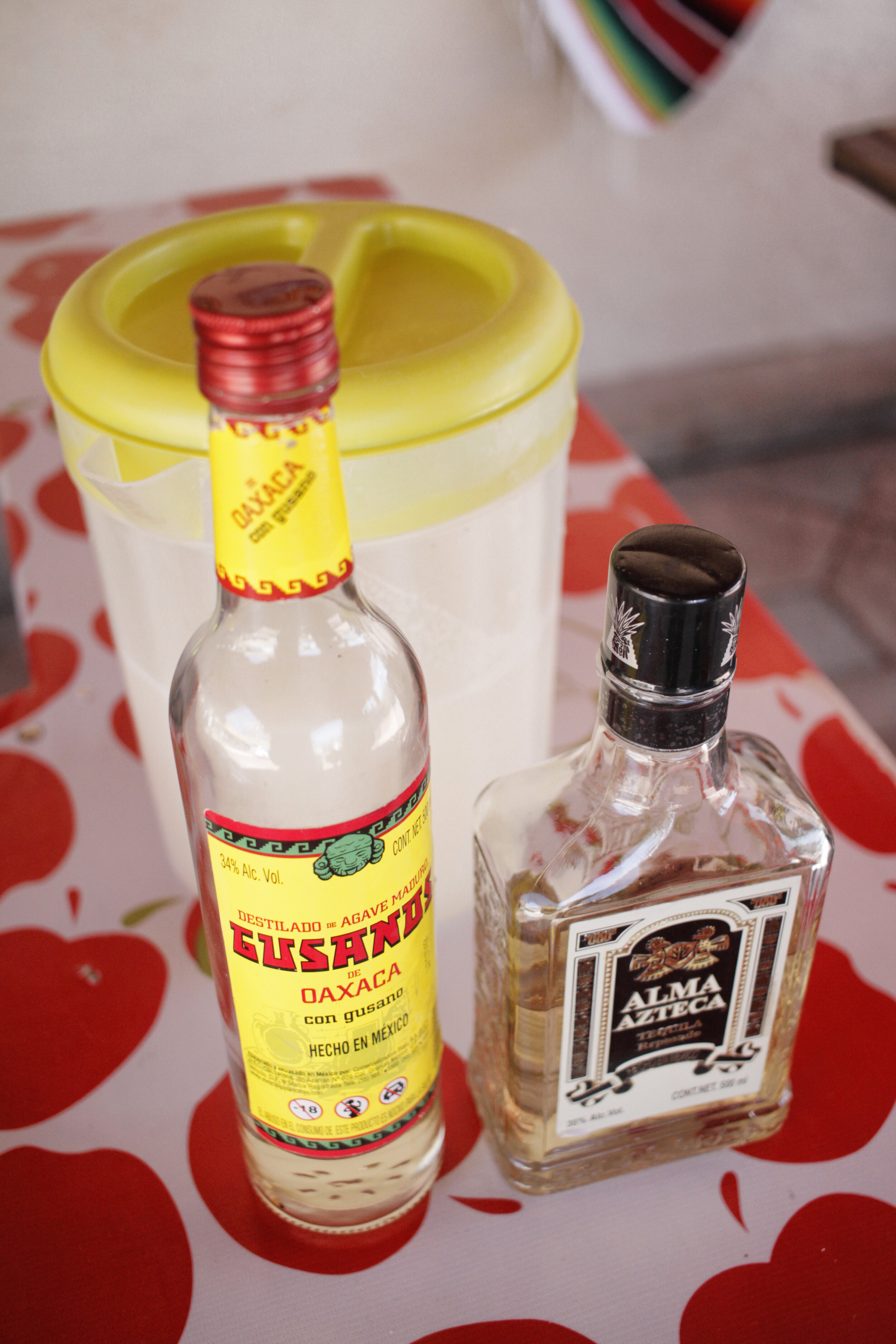Teotihuacán’s Pyramid of the Sun
Best things to do in Teotihuacán: float over massive, pre-Columbian pyramids with this travel guide.
Mexico, officially the United Mexican States, sits in the southern portion of North America.
It’s a country with the most Spanish speakers in the world and one filled with delicious food, vibrant culture, ancient Mayan ruins and stunning beaches.
A product of a rich Native American heritage, centuries of Spanish rule and sharing a border with the United States, Mexico is a land of diversity. Whether it’s tacos, Tulum or tequila, chocolate, Chichén Itzá or cenotes, Mexico has something to offer everyone.
Undoubtedly, Mexico shines but it’s Mexico City that’s packed full of so many wonderful surprises, whether it’s award winning restaurants, breathtaking architecture or a vibrant art scene but when our hotel told us we could float over nearby pyramids in a hot air balloon, I was beside myself.
Hot air balloons had been a childhood dream of mine for as long as I could remember, so after spending a few lovely days in the ancient Aztec city of Tenochtitlan, our stay, Carlota Hotel, organized private transportation to Teotihuacán and tickets to Sky Balloons Mexico for $225 USD a person.
Later on, to further our exploration of Mexico City’s culture and history we’d spend the day in Xochimilco at the floating gardens.
Best Things to do in Teotihuacán
Float / Over the ancient city of Teotihuacán
Experience / The pyramids up close
Learn / How to shoot tequila (the right way)
Best Things to do in Teotihuacán
Float Over the Ancient City of Teotihuacán
Early in the morning, a driver came to pick us up from Carlota Hotel in the heart of Cuauhtémoc neighborhood, better known as Zona Rosa in Mexico City. The drive was about an hour long but passed quickly, especially in the dark. We arrived on location before sunrise and filled out the necessary paperwork, drank a few tiny cups of milky coffee and bundled up for the chilly ride.
Around sunrise we were led out onto the grassy field as our enormous red and white balloon billowed with hot hair. Every few minutes the burner would shoot flames into the balloon, heating the air within, slowly growing in size and warming our cheeks with its flames.
Soon enough the balloon was nearly full and we started to see other balloons puff up and rise from the surrounding fields one by one. The anticipation was overwhelming.
Eventually, the basket began to tip upright and it was finally time to hop inside. Originally thinking we’d have the balloon to ourselves, like they show in the movies, but instead it was an enormous basket separated into little compartments. Three to four people jumped in each section, totaling about twenty passengers, including the pilot.
Very slowly the basket began to slide along the ground as it filled with hot air. Then we lifted, peacefully, quietly off the ground. Looking down as we rose upward, I saw a sign out on the grass saying, “Happy Birthday!” in Spanish. #bestbirthdayever
The sky became brighter as the sun began to rise and the horizon lit up in shades of pink, orange and yellow. The other balloons crept slowly through the air, all varying in color and pattern.
At first, we were so low to the ground you could see life happening below; people walking around or dogs barking in backyards but eventually we would rise so high it all became a blur. And then, off in the distance we could see a pyramid!
Located in San Martín de las Pirámides, the first pyramid of Teotihuacán we saw was the Pyramid of the Moon, the second largest in Mesoamerica (central Mexico, Belize, Guatemala, El Salvador, Honduras, Nicaragua and northern Costa Rica), after the Pyramid of the Sun. The Pyramid of the Moon covers another structure older than the Pyramid of the Sun existing before 200 AD and was used as a stage for performing ritual sacrifices of animals and humans. It was also a burial ground for these victims.
The balloon itself, was fascinating. I had imagined being jerked around, holding on for dear life but it was nothing like that. It moved slowly, thoughtfully through the air. The basket was sturdy, nearly wind proof with edges high enough that you couldn’t tip out even if you tried.
The flames were also really intense, not only to watch but as a source of heat. And the balloon was equipped with a little camera hanging just above our heads, taking photos every few minutes. Once you land, you’re able to purchase a memory card with all the photos from the flight. Also being my dads birthday, we filmed a ‘Happy Birthday’ message for him too; the perfect opportunity.
From this vantage point, we could see the entire site of Teotihuacán. The city's central avenue on the left, called Avenue of the Dead is bordered by massive ceremonial structures, Pyramid of the Moon (top left), Pyramid of the Sun (center and third largest in the world following the Great Pyramid of Cholula and the Great Pyramid of Giza) and The Ciudadela with the Temple of the Feathered Serpent Quetzalcoatl (bottom center).
Along the avenue, there are also many smaller platforms believed by the Aztecs to be tombs. Historians now know they were ceremonial platforms topped with temples.
As for the early history of Teotihuacán, it’s quite mysterious and the origin of its founders is uncertain. The city was the largest urban center of Mesoamerica almost 1,000 years before the height of the Aztecs and was already in ruins by their time. The earliest buildings at Teotihuacán date to about 200 BCE, while the largest pyramid, the Pyramid of the Sun, was completed by 100 CE.
For many years, archeologists believed it was built by the Toltec but because their peoples flourished centuries after Teotihuacán, they couldn’t have been the city’s founders.
Scholars have also speculated that an eruption of the Xitle volcano may have initiated a mass emigration of the peoples of Cuicuilco, located on the southern shore of Lake Texcoco, out of the central valley and into the Teotihuacán valley. These settlers may have founded or sped up the growth of Teotihuacán.
Others have thought that the Totonac peoples founded Teotihuacán and that it was a multi-ethnic state because many diverse cultural facets connected to the Zapotec, Mixtec and Maya peoples have been found.
Nonetheless, the builders of Teotihuacán took advantage of the geography in the Basin of Mexico as they built raised beds called chinampas, from the swampy grounds, creating agricultural success despite old methods of cultivation. These raised beds in turn created channels, and eventually canoe traffic which was used to transport food from farms around the city.
Interestingly, evidence of a king or other authoritarian ruler is shockingly absent at Teotihuacán. Artifacts of royal palaces, ceremonial courts, depictions of war and conquest have not been found leading many scholars to believe Teotihuacán was led by a “collective governance” of sorts.
As a child, I dreamt of flying through the air in a balloon so this was a dream come true. After soaring over the temples we continued on, up into the air for another hour. The experience was so peaceful and all around amazing. Although, I was happy to land eventually because all that coffee had caught up to me.
As we began the descent, I noticed a white van towing a trailer following us, zigging and zagging through the dusty roads below. This would be our ride back to the center. We were instructed to bend at the knees, crouch down and hold on tight as we landed with a thud in an open field. A handful of men came running to push the basket up onto the trailer.
After the basket was secure, we carefully hopped out while men began to remove the air from the balloon and fold it up into a tiny little lump.
Once everyone was out of the basket the team offered us a glass of champagne to celebrate. And then we made our way back to the center for some hearty breakfast of papaya with granola and chilaquiles.
Experience the Pyramids Up Close
From there, we entered the temple grounds on foot. On approach, we walked up the Avenue of the Dead where a few vendors were selling trinkets like figurines and scarves. I was shocked at how empty the grounds felt. Maybe it was timing but it seemed like we were the only ones there.
The scale of the pyramids was absolutely insane and the setting was breathtaking. They were up against a crisp blue sky filled with wispy white clouds. The sun was bright and the October air was cool and invigorating.
Some of the structures were open for exploring so we climbed up when possible, while others were roped off from the crowds. It felt quiet, respected by the guests, but exposed.
Teotihuacán is thought to have been established around 100 BC, and at its height around the first half of the first millennium the city was the largest in the pre-Columbian Americas with a population estimated at 125,000 or more, making it the sixth largest city in the world at the time. The city covered eight square miles with 80-90 percent of the valley’s population residing in Teotihuacán. The scale of Teotihuacán was truly felt from all directions.
Besides the pyramids, Teotihuacán is also anthropologically significant for its complex, multi-family residential compounds, the Avenue of the Dead, and its vibrant, well preserved murals. On top of that, Teotihuacán exported obsidian tools that have been found throughout Mesoamerica. The processing of obsidian was the most developed art and the main source of wealth for the area.
Found in mines nearby, obsidian was typically shaped into figurines, blades, spikes, knife handles, jewelry or ornaments. A specific type of obsidian blade, with a razor-sharp edge, was a ritual tool used in human sacrifices, where priests removed the heart from the victims.
Learn How to Shoot Tequila (the Right Way)
Once we were finished exploring the pyramids, our driver met us near the exit and we drove over to the gift shop area for a mezcal tasting. First, we learned a lot about agave and its uses from an enthusiastic local guide. Historically, agave fibers have been used to make clothing, footwear, building materials, fire and paper but it’s also used to make mezcal (and tequila).
Both tequila and mezcal are made from the harvested core of the blue agave plant, known as the “piña.” However, that's where the similarities in production end. To produce tequila, the bulb or piña is baked and juiced, then the juice is fermented with yeast in barrels. For mezcal, the bulb is cooked, mashed to obtain agave juice rich in sugar, fermented, distilled once, distilled twice and matured in barrels (mezcal may be rested or aged).
The tasting was delicious and informative. Our local guide taught us the correct way to take a shot. First, sprinkle a lime wedge with salt, squeeze the salted lime into your mouth and hold the juice there, take the shot, swish the mixture around and swallow. Surprisingly, it tasted much better this way, not to mention the quality of the tequila and mezcal was incredibly smooth, not like home.
So tequila is a type of mezcal, but mezcal is not tequila, and only mezcal has worms. The "worm" is actually a larva from one of two types of moths, known as maguey worms, that live on the agave plant. In the 1950s, a mezcal maker discovered the larva in the bottle and thought it improved the taste. From then on they were added to each bottle as a marketing strategy. And lucky me, I was left with the worm. For birthday luck, I swallowed it down in one big gulp. And with that, it was back to our adventures in Mexico City.

